#making duplicate blogs to get around block features
Explore tagged Tumblr posts
Text
“they’re not spam blogs, we vetted them!!”
yet here I am, blocking a duplicate of the same blog that sent me the same ask for the 4th time (the 3rd time today) along with another duplicate of the same blog I’d already blocked and reported that sent me the same ask they tried sending last week. and both of them still read like a fucking chatgpt prompt.
#g talks#anyone else notice a lot of the ones with men in the pfp use a variation of the same name#like one second leftists are screeching that palestinians don’t have internet so WE have to advocate for them online base on#what we think they want#but somehow they have enough internet to make tumblr blogs explicitly asking for money with pictures of random dead people#and debunked photos of the ‘destruction in Gaza’#and we’re just heartless monsters who support genocide if we question their spam behavior#I’ve seen some accounts like them on twitter#but this is a primarily tumblr thing#and I feel like these same people would be on all socials possible right#they’d want all the reach possible and they’re all free accounts#yet these people are only on tumblr#sending links to bogus gofundme accounts#making duplicate blogs to get around block features#how many times does it have to quack before you start believing it’s a goddamn duck#mine#/mobile#/okay to reblog
59 notes
·
View notes
Text
HIATUS (en)
What about my themes? I'm not taking commissions anymore, but all my themes will continue to be available for now, however I'm no longer updating them, so use them at your own risk!
Where to find me? You can still find me on my personal blog (@anyhsalinas). And if you have a theme/HTML/CSS/JavaScript related question for me, as long as it's a simple question I might have time to help you, so send it to my personal blog (here) ONLY. Don't even try to ask about these things on my other social medias where the focus is not coding, please, otherwise I'll block you (I had people doing this before and I get very annoyed by that, respect my spaces, please).
Why I'm quitting?
One of the biggest reasons why I loved Tumblr was the ability to customize our blogs however we wanted and turn it into our own space with our own style. And that's why I started making themes for myself and for other people. But over the last years Tumblr has kinda neglected this feature of the platform:
Clicking on a blog through the dashboard now takes you to a default dashboard-like page (this) and not to the customized version of the blog (this), which turned customizing your blog into something pointless because we take a long time customizing our theme only so that it might never even be seen by anyone;
This change also made it possible for people to send me messages without even seeing the rules for messaging me first;
And let's not forget the fact that now we need to contact Tumblr's staff to ask and wait for their permission in order to use JavaScript in custom pages, which makes things so unnecessarily more difficult for people who want to use our custom pages (they say it's for safety reasons, but it's still possible to use scripts on the main theme, so what's the point?).
Let's talk about writing posts as well:
We can no longer use basic HTML codes on posts which made it impossible for me to post tutorials (since it blocks the codes I'm trying to teach) -- which made me need to create a blog on Blogger to post my tutorials there, and have to simultaneously take care of two blogs on the exact same topics, which is kind of annoying;
Also the new post editor has been very buggy for me. Sometimes when I try to copy a portion of the text I'm writting it just won't copy no matter what. Sometimes it will duplicate paragraphs on its own for no reason...
Tumblr has also made some bad decisions (in my opinion at least) over the years of what kind of content to allow in the platform which caused serious problems to the platform itself (as you might have seen in the news around that time), but even before that also caused a big change in its community and the majority of the blogs I loved (the meme, poetry and fandom blogs of shows and bands I like) moved to Twitter (I still refuse to call it "X", lol) and other social medias. So most of what I loved about this platform is gone forever and the only things still keeping me here are the things I have saved in my blogs, my liked posts and drafts (mostly custom content and mods that I found here for The Sims, lol).
I haven't been using Tumblr regularly in... years, actually. Only sometimes I pass by. And I no longer enjoy developing themes for this platform because now, after all these changes, it has turned into something kinda pointless. Also, I've been busy with other projects that are bringing me more joy at the moment, such as my Youtube channels and crafting. So I'm leaving behind this part of my life... I don't like saying this is an end because I can always change my mind. But unless Tumblr goes back to making our custom theme as the main page of our blogs (instead of that default dashboard-like boring page), I don't think I'll go back to making themes for this platform.
But thank you all for your support in this blog and for using my codes through all of these years! Wish you all the best. 💕
— Anyh's Themes (2013 - 2024)
14 notes
·
View notes
Text
This seems to suggest an interest in sending users to something other than what they’ve clicked on a link to. If someone clicks a link to see a specific post, they probably want to see that specific post and not random other content. SEO probably isn’t a bad idea, as long as it’s still possible for people to use the site for what it is.
The user already doesn’t know how to navigate the application, because the buttons move around with every update for (as far as I can tell) no particular reason. I suspect any format would be fine if it were consistent, but it seems to me that every time I open the app or the site some button (shop, my page, the post button, etc) has moved. It’s unclear to me how much can change with the “first 25 posts” issue. To my knowledge, new users already have the “best stuff first” toggle on, while many established users have turned it off. As someone who has been using this site for the past 7 years, I think I speak for many users when I say that the feed still being chronological is one of the best features Tumblr has. All I ask is that the toggle still exists, and users are still able to choose a chronological format to their dashboard. I fully agree that the search feature needs some major improvements, and has for a long time. This is the first thing in the post I’m genuinely excited for, since Tumblr’s search function has been lacking for a long time, and for reasons unclear to me. Thank you for looking into it.
I like the idea of removing duplicate reblogs, I think there’s a lot of potential to that. It’s unclear to me what it would mean to “collapse reblog threads”, but as long as it doesn’t limit users’ ability to see what people are saying I don’t think it’s inherently a bad thing. The rest of this point doesn’t make a lot of sense to me, but I do want to mention that the unique conversational way reblogs work is one of Tumblr’s defining features, and one that many users would be sad to see go. We’re happy to use Tumblr, we don’t really want Twitter 2.
The “outdated decision to only show content from followed blogs” on the following page? That’s the purpose of the following page. Again, this seems like a change designed to create Twitter 2, which is a good way to lose Tumblr users uninterested in that style of social media platform. I agree that we need to prioritize supporting new creators, but I don’t think spamming people with content they don’t want is a good way to accomplish that. If users are spammed with content they didn’t ask to see, some users are going to respond with anger, negativity, and hateful messages, much the way that everything on Twitter gets covered with anger and negativity because people are seeing content they didn’t ask to see. This might make new creators more visible, but it would also make them more vulnerable, and worsen the user experience for everyone else. I wholeheartedly agree on the need to limit notification spam, and this is a great direction to move in. Embedded links are another positive change.
Most of this seems fine to me, I don’t have strong opinions on it. I will say, though, that if users have push notifications off that may be because they don’t want notifications, and email spam isn’t necessarily going to be helpful with that. For example, I don’t get tumblr notifications on my phone, and if I started getting emails for every like and reblog, I would block Tumblr’s email address, because I use my email for communication that’s more time-sensitive.
Wholeheartedly agree on this point, unless I’m missing something important. Tumblr, in the minds of a lot of people, is synonymous with weird bugs and a broken website, but it doesn’t have to be. I think heavy focus on this is probably the best place to be putting attention at the moment.
Tumblr is a site with a unique style in the modern age, and that’s a part of what makes it work. When Tumblr tries to copy other social media’s features (livestreaming, non-linear post feeds, etc.), it risks alienating the longtime users and creators who keep the website interesting.
I like this site, and I'd like to keep using Tumblr, not Twitter 2. Thank you.
Tumblr’s Core Product Strategy
Here at Tumblr, we’ve been working hard on reorganizing how we work in a bid to gain more users. A larger user base means a more sustainable company, and means we get to stick around and do this thing with you all a bit longer. What follows is the strategy we're using to accomplish the goal of user growth. The @labs group has published a bit already, but this is bigger. We’re publishing it publicly for the first time, in an effort to work more transparently with all of you in the Tumblr community. This strategy provides guidance amid limited resources, allowing our teams to focus on specific key areas to ensure Tumblr’s future.
The Diagnosis
In order for Tumblr to grow, we need to fix the core experience that makes Tumblr a useful place for users. The underlying problem is that Tumblr is not easy to use. Historically, we have expected users to curate their feeds and lean into curating their experience. But this expectation introduces friction to the user experience and only serves a small portion of our audience.
Tumblr’s competitive advantage lies in its unique content and vibrant communities. As the forerunner of internet culture, Tumblr encompasses a wide range of interests, such as entertainment, art, gaming, fandom, fashion, and music. People come to Tumblr to immerse themselves in this culture, making it essential for us to ensure a seamless connection between people and content.
To guarantee Tumblr’s continued success, we’ve got to prioritize fostering that seamless connection between people and content. This involves attracting and retaining new users and creators, nurturing their growth, and encouraging frequent engagement with the platform.
Our Guiding Principles
To enhance Tumblr’s usability, we must address these core guiding principles.
Expand the ways new users can discover and sign up for Tumblr.
Provide high-quality content with every app launch.
Facilitate easier user participation in conversations.
Retain and grow our creator base.
Create patterns that encourage users to keep returning to Tumblr.
Improve the platform’s performance, stability, and quality.
Below is a deep dive into each of these principles.
Principle 1: Expand the ways new users can discover and sign up for Tumblr.
Tumblr has a “top of the funnel” issue in converting non-users into engaged logged-in users. We also have not invested in industry standard SEO practices to ensure a robust top of the funnel. The referral traffic that we do get from external sources is dispersed across different pages with inconsistent user experiences, which results in a missed opportunity to convert these users into regular Tumblr users. For example, users from search engines often land on pages within the blog network and blog view—where there isn’t much of a reason to sign up.
We need to experiment with logged-out tumblr.com to ensure we are capturing the highest potential conversion rate for visitors into sign-ups and log-ins. We might want to explore showing the potential future user the full breadth of content that Tumblr has to offer on our logged-out pages. We want people to be able to easily understand the potential behind Tumblr without having to navigate multiple tabs and pages to figure it out. Our current logged-out explore page does very little to help users understand “what is Tumblr.” which is a missed opportunity to get people excited about joining the site.
Actions & Next Steps
Improving Tumblr’s search engine optimization (SEO) practices to be in line with industry standards.
Experiment with logged out tumblr.com to achieve the highest conversion rate for sign-ups and log-ins, explore ways for visitors to “get” Tumblr and entice them to sign up.
Principle 2: Provide high-quality content with every app launch.
We need to ensure the highest quality user experience by presenting fresh and relevant content tailored to the user’s diverse interests during each session. If the user has a bad content experience, the fault lies with the product.
The default position should always be that the user does not know how to navigate the application. Additionally, we need to ensure that when people search for content related to their interests, it is easily accessible without any confusing limitations or unexpected roadblocks in their journey.
Being a 15-year-old brand is tough because the brand carries the baggage of a person’s preconceived impressions of Tumblr. On average, a user only sees 25 posts per session, so the first 25 posts have to convey the value of Tumblr: it is a vibrant community with lots of untapped potential. We never want to leave the user believing that Tumblr is a place that is stale and not relevant.
Actions & Next Steps
Deliver great content each time the app is opened.
Make it easier for users to understand where the vibrant communities on Tumblr are.
Improve our algorithmic ranking capabilities across all feeds.
Principle 3: Facilitate easier user participation in conversations.
Part of Tumblr’s charm lies in its capacity to showcase the evolution of conversations and the clever remarks found within reblog chains and replies. Engaging in these discussions should be enjoyable and effortless.
Unfortunately, the current way that conversations work on Tumblr across replies and reblogs is confusing for new users. The limitations around engaging with individual reblogs, replies only applying to the original post, and the inability to easily follow threaded conversations make it difficult for users to join the conversation.
Actions & Next Steps
Address the confusion within replies and reblogs.
Improve the conversational posting features around replies and reblogs.
Allow engagements on individual replies and reblogs.
Make it easier for users to follow the various conversation paths within a reblog thread.
Remove clutter in the conversation by collapsing reblog threads.
Explore the feasibility of removing duplicate reblogs within a user’s Following feed.
Principle 4: Retain and grow our creator base.
Creators are essential to the Tumblr community. However, we haven’t always had a consistent and coordinated effort around retaining, nurturing, and growing our creator base.
Being a new creator on Tumblr can be intimidating, with a high likelihood of leaving or disappointment upon sharing creations without receiving engagement or feedback. We need to ensure that we have the expected creator tools and foster the rewarding feedback loops that keep creators around and enable them to thrive.
The lack of feedback stems from the outdated decision to only show content from followed blogs on the main dashboard feed (“Following”), perpetuating a cycle where popular blogs continue to gain more visibility at the expense of helping new creators. To address this, we need to prioritize supporting and nurturing the growth of new creators on the platform.
It is also imperative that creators, like everyone on Tumblr, feel safe and in control of their experience. Whether it be an ask from the community or engagement on a post, being successful on Tumblr should never feel like a punishing experience.
Actions & Next Steps
Get creators’ new content in front of people who are interested in it.
Improve the feedback loop for creators, incentivizing them to continue posting.
Build mechanisms to protect creators from being spammed by notifications when they go viral.
Expand ways to co-create content, such as by adding the capability to embed Tumblr links in posts.
Principle 5: Create patterns that encourage users to keep returning to Tumblr.
Push notifications and emails are essential tools to increase user engagement, improve user retention, and facilitate content discovery. Our strategy of reaching out to you, the user, should be well-coordinated across product, commercial, and marketing teams.
Our messaging strategy needs to be personalized and adapt to a user’s shifting interests. Our messages should keep users in the know on the latest activity in their community, as well as keeping Tumblr top of mind as the place to go for witty takes and remixes of the latest shows and real-life events.
Most importantly, our messages should be thoughtful and should never come across as spammy.
Actions & Next Steps
Conduct an audit of our messaging strategy.
Address the issue of notifications getting too noisy; throttle, collapse or mute notifications where necessary.
Identify opportunities for personalization within our email messages.
Test what the right daily push notification limit is.
Send emails when a user has push notifications switched off.
Principle 6: Performance, stability and quality.
The stability and performance of our mobile apps have declined. There is a large backlog of production issues, with more bugs created than resolved over the last 300 days. If this continues, roughly one new unresolved production issue will be created every two days. Apps and backend systems that work well and don't crash are the foundation of a great Tumblr experience. Improving performance, stability, and quality will help us achieve sustainable operations for Tumblr.
Improve performance and stability: deliver crash-free, responsive, and fast-loading apps on Android, iOS, and web.
Improve quality: deliver the highest quality Tumblr experience to our users.
Move faster: provide APIs and services to unblock core product initiatives and launch new features coming out of Labs.
Conclusion
Our mission has always been to empower the world’s creators. We are wholly committed to ensuring Tumblr evolves in a way that supports our current users while improving areas that attract new creators, artists, and users. You deserve a digital home that works for you. You deserve the best tools and features to connect with your communities on a platform that prioritizes the easy discoverability of high-quality content. This is an invigorating time for Tumblr, and we couldn’t be more excited about our current strategy.
65K notes
·
View notes
Text
Blog Post 15: Adding the Skull Cluster at the Base
To enhance the statue's atmosphere, I added a cluster of skulls around the base of the pillar, which gives it a deeper, darker appearance.
I started by making a simple blockout model of the pillar in Maya to ensure that the structure and proportions were correct. After the form was stable, I exported it to ZBrush so that it could be detailed.

I added decorative patterns to the upper part of the pillar using ZBrush, paying particular attention to the edges and corners. I intended it to resemble a blend of random patterns and architectural details, like those found carved into ancient temple buildings.
I started sculpting fractures, broken edges, and damage to give it a worn-out, old appearance after adding layered stone blocks underneath. There is obvious erosion and chipped carvings in some places, and I added texture and roughness in some places using surface noise.
I used ZRemesher to retopologize the mesh and get a clear low-poly version when I finished sculpting. To create a new high-poly version for baking, I then divided and duplicated the retopologized mesh. This made it possible for me to transfer every sculpted feature from the original sculpt onto a perfect mesh that was ready for texturing and had the right edge flow. Here’s a look at the sculpted pillar:


Detailed ZBrush sculpt of the pillar – includes ornamental designs, cracks, and worn surface detailing.
0 notes
Text
@faeriefrog-blog asked how i did the funny colours on these bad boys so i've broken it down into a few steps!!! starting with the bottom most layers:
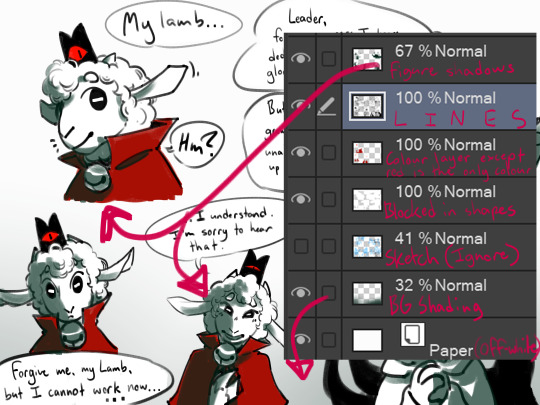
very bottom layer, just above the paper itself, we've got the background shading seen in the bottoms images here, panels 3-5 in the comic. note that without any effects applied to it, it is the same colour as the shadows, a deep teal hue. i like to keep all the shadows around the same hue for the sake of cohesion, even though these end up being altered quite a lot in the final product
a note about the base paper layer!! its not actually pure white, but very very light grey. sometimes i make it a slightly darker grey if im feeling dramatic. this keeps the focus on the figures on the foreground probably, and allows the paper layer to interact just a little bit more with colour altering layers above it (overlay layers, for example, dont do SHIT to pure white)
above the paper, the bg shading, and the sketch layer i was too lazy to remove, we've got the blocking ive put down so that the lamb, the speech bubbles, and the sweet elderly koala theyre about to yeet into the great beyond are both not grey and not fading into dark teal. this layer probably wouldnt be here if it was fully coloured!!! however, i love not doing things :]
then theres the one-colour colour layer, and the lineart, of course, normal stuff, and then the topmost layer in this chunk is the figure shading. this can be put above or below the lines if you prefer, since it wont be at full opacity anyways. teal is a pretty strong feature in the cotl palette, esp in toww's domain, so i tend to shade with teal a lot here. not much details of variation in shading strength is applied here, the only notable exception being the bell which i straight up just could not resist making all shiny. since the shading is blocked in with a sketchy pencil brush i use for like all of my art steps, it creates the idea of texture without much real effort.
directly above the shading we have this shit:
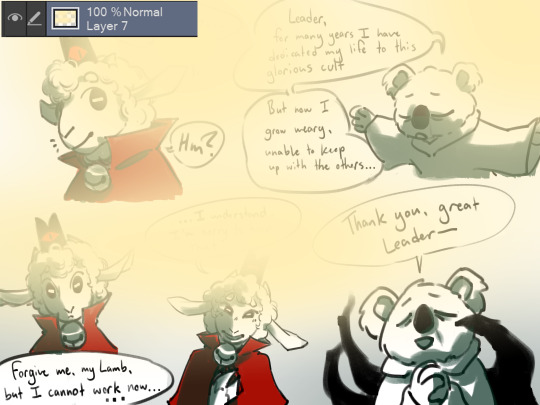
shown at normal and full opacity because i need to emphasize these are literally just gradient ovals of pale yellow and it looks silly but:
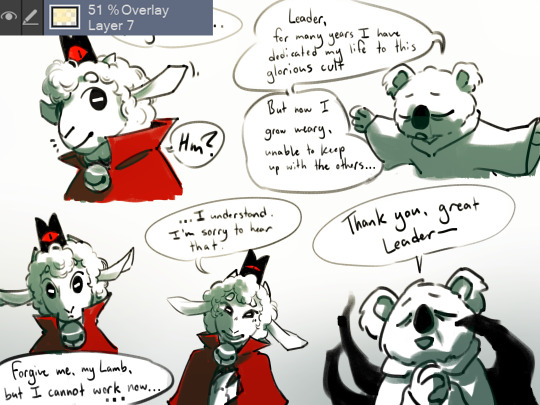
set that bitch to around 50% opacity and make it an overlay layer and it adds some light and depth to the shaded areas!! note that as i stated before, it is now completely invisible on the sections that are blocked in white, and has little effect on on the black lineart. it doesnt have to be super detailed or precise, but just have the gradient positioned in a way that suggests a source of light
finally, the topmost two layers:
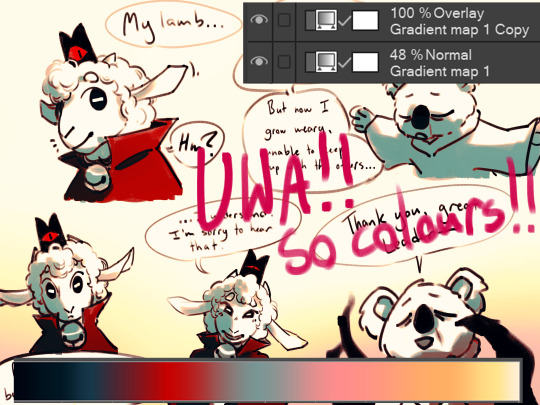
the gradient map here i what i use for most of my cotl stuff, though i poke and prod at it with every image to ensure the shadows are deep and the red is vivid. then duplicate that layer, make the bottom layer somewhere around 50% opacity, and make the topmost layer an overlay. i dont know with any fancyboy words WHY this specifically works; as best as i can figure, the bottom layer applies the colours, while the upper layer improves contrast and colour depth while keeping it within the colour scheme
thats it!!! once you get used to using overlays and gradients, this becomes quite simple, which is nice because i can use these tricks on top of a little low-energy doodle i did about old people murder and have it come out really nice still!!! i love things that save me time and energy!! if you do too, i hope this is helpful!! :]


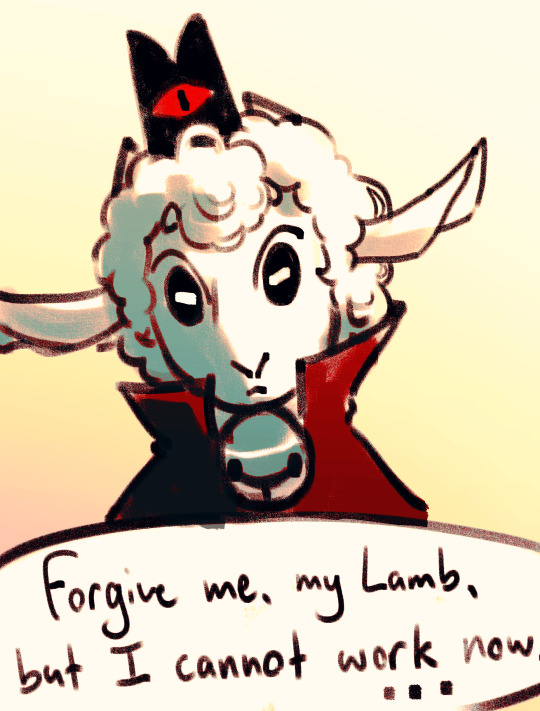




cult trait: good die young
4K notes
·
View notes
Text

#CELESTRAHL ( celestial + strahl (german, meaning beam/ray) ) — an independent, mutuals only and selective multimuse roleplaying blog featuring canon and original characters from various video game franchises!
Written & loved by Faye, 31, she/her, GMT+1. 18+ only, minors dni!

CURRENT PRIMARY/SECONDARY/TERTIARY MUSES: OC: Tae Suzuya¹, Violet Celeste² ASSASSIN'S CREED: Élise de la Serre³, Evie Frye³ DEVIL MAY CRY: Nero¹, V² DRAGON AGE: Lucanis Dellamorte³ FINAL FANTASY: Dion Lesage³, Lunafreya Nox Fleuret², Noel Kreiss¹, Oerba Dia Vanille², Serah Farron¹ RESIDENT EVIL: Luis Serra¹
All of my muses have multiple verses, including AUs, and are available for crossovers! ✨

Currently low activity with random bursts.
Mobile Rules can be found below the cut! ⬇
★ First off, don’t be an ass. Godmodding, infomodding, metagaming, whatever else these things are called, have no place here. Don’t kill my muses. Don’t kill any of their friends/family/allies right in front of them without discussing it first. Character ≠ Writer, I’m not my muses and if my muses are in any way mean to your muse/s doesn’t mean I’m being mean towards you. If you have criticism, please remain respectful and constructive when sending it in. Anon hate will be deleted/blocked.
★ I’m strictly interacting with mutuals only. If you followed me and I didn’t follow back I either do not know anything about your character’s fandom, find your blog lacking information and/or simply cannot see us interact. I’m also trying to keep my dash a comfortable space for myself so please don’t take it personally if I don’t follow back. But if I do follow you, I’m interested in writing with you – and I will assume the same if it’s the other way around.
★ I will not follow if you do not cut and/or tag your posts.
★ I’m selective, or rather, my muses are – and sometimes certain muses are louder than others, and some might even take over the blog for a bit. Please don’t get discouraged or disappointed if you see me replying to certain threads with certain muses only, or only to threads in certain genres.
★ I generally prefer writing threads over meme responses, and I love plotting. I normally tend to write semi-paragraph, paragraph and multi-paragraph things with the rare occasional one-liner.
★ I encourage you to turn my ask responses into threads! I always put character asks into a new post anyway, so feel free to reblog that and add your reply! No need to ask beforehand!
★ Please do not apply any fancanons to my muses, no matter how popular or widely accepted they are.
★ Relationships in all forms (romantic, platonic, familial, rivals, you name it) are welcome, however there has to be chemistry and I would like if you asked me beforehand and if we’ve written before. One-sided crushes and unrequited feelings are fine too, just don’t try to force your character on mine and we’re cool. I DO NOT AUTO-SHIP CANON ROMANCES. Please also understand that some of my muses can be difficult to bond with.
★ I will practice mains and in rare cases ship exclusives, but not affiliates or general exclusivity.
★ Duplicates/Variants are, honestly, a bit tricky for me. I’ve had both good and bad experiences with them in the past. Overall I’m trying to be indifferent towards them. I hope you understand that I’m a little hesitant regarding this!
★ I am OC friendly! How could I not be, having my own OCs on this blog? The only point where I draw the line is when it comes to OCs who are children of canon characters.
★ NSFW isn’t very likely to occur here. I will not write smut, should any thread ever go in that direction it will fade to black before anything spicy can happen. I'm not someone to write anything blood & gore related in explicit detail either.
★ Triggers will be tagged as _____ tw and _____ cw so make sure to blacklist yours this way. If you have a rather uncommon/rare trigger that you need tagged, please let me know!
★ Do not take anything from this blog. Be it icons and/or other graphics I’m using in my own posts, headcanons and/or parts of my theme code. I created/wrote/edited these things myself (for some things see credits below) and would very much appreciate it if you could just leave them be. I’ve had quite a few bad experiences with theft in the past, so this is something I feel I have to mention.
★ Lastly, hi! I go by Faye, I’m 31, she/her, from Germany. I’m honestly just a big nerd for video games and I love music, writing, graphic editing, reading and more. I just generally love being creative and am passionate about everything I create. I don’t know what else to tell you here, but if you ever wanna get to know me my IMs are always open, and my Discord is available for mutuals. If you’re reading this, I hope you have a good day!!
CREDITS Lightning Returns Noel Kreiss Raw Icons, FFXIII Oerba Dia Vanille Raw Icons, Lightning Returns Oerba Dia Vanille Raw Icons, FFXIII-2 Serah Farron Raw Icons, FFXV Lunafreya Nox Fleuret Raw Icons all from @dresspheres
Evie Frye Screencaps taken by Steph
Serah Farron Icon Border made by @ennakros
All other screencaps and graphics were taken & edited by me.
2 notes
·
View notes
Text
rules.
01. following and activity.
i am mutually exclusive and low activity. writing is my job outside of tumblr too, i have quite a few other blogs, and sometimes i simply don't have the energy to do threads at the end of the day. my energy can be extremely sporadic so please keep this in mind when following.
i highly prefer plotted interactions. i will very rarely post starter calls but i am always open to having mutuals message me asking to plot. in addition, i reblog a lot of memes so if you want to interact, sending one of those in is the best way to get a thread started!
i will only write with those who are over 18. this is simply because i am 20+ and being considerate of younger writers on this site considering the source material.
02. interactions.
i can be fairly selective with who i decide to follow - i generally follow (back) if i can see potential for plotting and also i think that we would get along well out of character. i can take some time to follow back because trying to do anything with my brain is like pushing a 2002 ford taurus uphill so please do not follow / unfollow for attention.
i generally only break mutuals if you have not been active in over two months, we haven't particularly interacted, or i've been notified by a friend of something i wasn't aware of in the past ( such as racist / sexist / transphobic etc behavior. ) in all cases i will softblock.
+ for my own comfort, i won't write or interact with the following media unless i am friends with the person: american horror story, riverdale, chilling adventures of sabrina, descendants, any rooster teeth property, most anime/manga.
03. characterisation and content.
caleb is not a nice person at all. he’s manipulative and self serving and is more than willing to throw your muse under the bus if it means furthering his goals. he’s also extremely powerful and capable of affecting characters who are still alive including possession. he truly cares for little other than himself and i will not shy away from this in threads. any hostility from caleb does not reflect on me, the mun’s, perception of you or your character. he’s the villain and will behave like a villain.
in addition, while julie and the phantoms is generally intended for younger audiences, i will approach some more mature themes as they make sense for caleb’s character. most prominently will be themes of death, grief, and some more horror aspects depending on his verse. if you don’t feel comfortable with that, you are not obligated to write with me. i simply would like to approach a version of his character that’s less like a cartoon/disney villain and more nuanced.
since we don’t really have any lore on how the ghosts and their abilities work, most of the lore about caleb’s abilities has been created by me. if you’re writing another jatp muse and would like to borrow it, you’re fine as long as you ask me first. please just don’t copy and paste it without acknowledging that it’s been borrowed.
04. shipping.
caleb is straight and thus i will only write romantic content with woman-aligned characters. shipping will probably be pretty rare considering he’s been dead since the fourties and also he’s a self absorbed bastard. i also will not be featuring nsfw content on this blog in any capacity. even though caleb is an adult, the source material is a kids show and i don’t feel comfortable including nsfw content in that regard.
05. everything else.
i use minimal formatting with 60x60 icons. i will probably not follow back if you do ‘photoshop’ replies or super spaced out ones just because it’s insanely hard for me to actually read and absorb those.
i won’t be following duplicates just to tailor my own experience to what i’m comfortable with. no hard feelings!
personals will be blocked. this ain’t your space.
at the end of the day, if you’re not a dickhead, we will get along fine.
06. supplemental.
hi there! i'm pidge; i'm 20 years old, transmasc, and living in yuggera country ( queensland, australia. ) i currently work in customer service and studied film production at university, writing and directing content is my ultimate end goal. this isn’t my first rodeo writing a jatp character so you may already know me!! i'm also a big fan of suburban gothic, iced coffee, and podcasts. i am generally around at odd hours but my discord is always open to mutuals. where else you can find me: bucky barnes, ethan winters, jesse faden.
1 note
·
View note
Text
DISCLAIMER AND RULES
These are the UPDATED directions/guidelines for all who want to participate/contribute to this blog. Our topics of conversation revolve mostly around 30 Seconds to Mars/the Leto Bros, but we have been known to also discuss various other current events around the world.
By reading, and especially by contributing, on what goes on around this blog, you are willingly agreeing with all guidelines and directions I have mentioned below - no exceptions.
I am willing to give a space to those who wish to discuss Mars (or other topics), and I am washing my hands from any and all fuckery that may ensue from other people´s opinions.
Also worth mentioning: I am fully aware that some people who publicly and very vocally denounce any interest in either this blog or Mars gossip lurk around this blog and then spread shit elsewhere on the internet.
By doing that, you are essentially outing yourself as a quiet kmp78 admirer, so to speak.
Or a fangirl, if that suits better. 🤗

Alright then... READ.
1. This blog is laced with sarcasm, jokes, stupid and often very dark humor and PERSONAL OPINIONS - both mine and the people who participate in our conversations. This is not CNN, BBC or even Fox News - this is a personal blog run by a (sort of) fan. Not someone with inside information, and not someone whose opinions and views should be taken too seriously, and definitely not as gospel. I have no direct access to anyone in the Mars organization, and I do not work for them.
2. Nor do I work for YOU. This may be a blog which is mainly used for discussions about all things Mars and all opinions and topics are welcome, but the only one in charge is ME. I decide if a message gets published, if a message gets edited, if a message gets deleted - and if the sender gets blocked.
And not that it really needs to be said, but here goes anyway: I do not work for any Leto troll either.
3. And speaking of blocking:
those who send threats or offensive messages will be blocked, as will anyone who I deem block-worthy. Rest assured, I never block anyone without a reason, so if you should discover that you have been blocked, that means I had a reason. I may or may not inform publicly when a person has been blocked, depends on my mood.
4. Everyone who sends messages is responsible for their own words - I do not accept any blame for other people´s opinions. Misunderstandings by accident or on purpose are not my headache. If I suspect a message will potentially cause unnecessary problems or annoyance for me, I will not post it (or will edit it), and I don´t owe anyone any explanations as to why I´m not posting it. I may explain, or not - that´s up for me to decide.
In any case, as I said: I will not take responsibility for anyone else´s words other than mine, and screaming at me over here or elsewhere online regarding comments someone else made and I posted...
Well, that´s just infantile. 🙄
5. All opinions are welcome, positive AND negative. A positive opinion does not automatically make you a sheep, and a negative opinion does not automatically make you a hater.
Readers to this blog should be adult enough to handle both sides.
6. Calling women sluts or whores is not ok here.
You also need to be able to tell the difference between calling a woman a whore and calling a Leto a whore. If you can´t understand the difference, then get out immediately.
SPECIAL CLAUSE:
the term “YACHT GIRL” when used in connection with an actually legit model who YOU ARE JEALOUS OF BECAUSE SHE GETS TO BONE A MAN YOUR FLABBY LOINS BURN FOR, actually is the equivalent of you calling her a whore, so kindly DO NOT.
Use whatever brain cells your parents genes bestowed upon you and make them at least somewhat proud. That should hopefully partially make up for the disappointment they most probably are already feeling knowing you actually read and participate in this shit.
7. What is also not ok is accusing people of crimes, calling them psychopaths, or threatening others with physical violence etc. - not even sarcastically or as jokes.
Think of it this way:
when typing your message, if at any point you think that what you are writing might come across differently or more seriously to the person reading it than to you while writing it - then do not write it. Any innuendo about people´s potential “social diseases” is not welcome either, and neither are accusations of “obsessions” and people “stalking” the men this blog is focused on. Be VERY careful when using these terms.
YOU are responsible for your own words. I cannot stress that enough.📣
8. We use a lot of initials and nicknames in our conversations - for a reason.
Do not use people´s real names in messages.
If you do not know who a particular person is, please come ask via chat (directions on how to use the chat feature can be found here). I may or may not blur out a name in a message if I think it´s necessary.
9. I post a lot of pics, gifs - and most of them are found from Google using various search terms, and sadly have no tags or indications as to who is the owner/maker. I don´t own any of the pics or gifs, or videos for that matter either (except the ones I have made and labeled as my own). If you find something of yours posted and prefer not to have it up or to have your name added as credits, please let me know and I will remove it.
As for links to either newspaper articles, IG accounts, other blogs or the like: you can find credits to the sources by either clicking on the links, or if I have decided to post screen caps, in the pics themselves. Again, I do not write articles or make videos and very, very rarely post anything other than other people´s comments - after all, this is prominently a discussion blog now. Opinions/messages from other people represent THEIR views and thoughts, my views/thoughts can be seen in my answers (in case of submits or multi-part messages, you will find my contributions to the message after this sign: ***).
To make this very clear: we don´t make news here, we discuss them.
10. When sending submits, if you are unsure of others potentially seeing your “ID”, please mention in your message that you want to remain anon and I will post it anon. Also please remember tho that there is no such thing as complete anonymity - so be careful when writing down your thoughts. Censor yourself if necessary - don´t make problems for me or others, or yourself.
11. I use Statcounter on this blog, which means I can see IP addresses from people visiting this site. However I choose to use that information is up to me, so if you are scared shitless of being outed due to your own actions/words, then DO NOT COME HERE.
If I out your IP, then there is a reason for it.
Don´t give me reasons if you want to remain in the shadows.
(And same goes for chat messages btw: don´t pretend to be my friend in private, but then turn your back and stab me in it in public. More often than not I WILL find out, and if I choose to then out your bullshit by posting private messages, THAT´S ALL YOUR OWN DOING, KIDDOS.
Play nice with me and you have nothing to worry about.
Start kicking dirt in my face and...🤷♀️
12. If you are addressing your message directly to someone (= other than me), please say so CLEARLY in your message, for example by starting your message with “For anon who said...”, or something along those line. I have had it with misunderstandings and unnecessary messes due to unclear messages! BE SPECIFIC!
13. ONLY write either in English or Finnish. I won´t waste my time on Google Translate, I have enough on my plate as it is and your weirdo mongrel lingos are boring as hell anyway.
14. DO NOT SEND MESSAGES WITH THE SOLE PURPOSE OF STIRRING UP SHIT - OR TO INSULT OTHER COUNTRIES OR NATIONALITIES. That would rank quite high the PATHETIC categories...
15. I won´t post content from so-called private/non-celeb accounts such as Leto trolls (= VK for example IS a celeb so whatever she posts is most deffo getting posted, but anything posted by Lesser´s harem probs won´t be).
16. READ PREVIOUS MESSAGES! READ PREVIOUS MESSAGES! READ PREVIOUS MESSAGES! READ PREVIOUS MESSAGES! READ PREVIOUS MESSAGES!
I´m beyoooooooond bored answering the same questions over and over again, sometimes in the space of just a few hours! The archives and search option are available on my blog for a reason! USE THEM. 😠
17. When sending messages containing info or “receipts” or whatever it may be that you think we should be made aware of, either clearly state WHERE that info can be found and WHO you are talking about. Do not simply send a message a´la “VK can be seen on Monica´s/Richard´s/Beatrice´s IG”. We don´t know who these people are! You may, but we don´t! I do not follow a single model or fashion industry creeper on social media so FIRST NAMES mean fuck all to me. GIVE FULL DETAILS OR SHUT THE FUCK UP.
18. IF I SAY A TOPIC IS OFF-LIMITS, THEN YOU WILL RESPECT THAT.
19. I usually try to post messages in the same order they have been sent - with a few exceptions:
If a situation arises which calls for “immediate attention” (new troll pics or other sudden Mars-related activity, for example), I may leave older messages for later and focus on newer ones first. Also when I am operating on my mobile, I am often unable to post certain messages (videos etc.), so those will be left for later when I am back to an actual computer.
20. More often than not, tumblr fails to deliver messages to my inbox. If you suspect that yours has not been delivered, please send it again. I don´t mind getting duplicates.
21. If I feel that a message offers no relevant or needed content, I won´t post it. For example, a message such as “JL & XX in Japan bang bang” is unnecessary and pointless and not worth posting. I only have 250 allowed posts per day, and on busy days I have to make judgments on what is worthy of posting and what is not. I apologize if I therefore have to skip some messages.
When I run out of allowed posts here, I will let everyone know that I am switching over to use the secondary blog which can be found at @kmp78secondaryblog
(PLEASE NOTE: That blog is ONLY used when we run out of room here, and I never go there unless I have to so please don´t send any messages to that blog unless I inform we have to move there!)
AND FINALLY PLEASE REMEMBER:
THIS IS A FANDOM FOR A BAND. NOT A MATTER OF LIFE AND DEATH. ACT ACCORDINGLY.
Creating hater accounts dedicated to POSTING PICTURES OF MY BLOODY EYEBALL (that btw actually happened because of course it did! This is the echeLOOOOOON after all! 👍) won´t make me quit this blog, so...
Yeah.
Anyway, for further information, please contact me via private message here, on my IGs, or at [email protected].
Thank you. 🙏
PS: In case you run into accounts/comments made under my tumblr “identity”, or otherwise unauthorized “kmp78″ activity outside of tumblr which you recognize as being linked to this blog in any way (such as my posts being tagged with JL´s tags etc.), please report them immediately, both to the admins of the sites you found these accounts on, and to me directly so I can take appropriate action, thanks.
Any of my personal pics taken from this blog have been taken without permission and I have never and will never give permission to post them anywhere. And when I say I “appropriate action”, I mean just that. If need be, I will be contacting the authorities, like I did when I received public death threats.
Be very aware that my tolerance for that is less than zero - and also be aware that these guidelines and my rules may change whenever I feel the need to change them.
#DEAL ✌️
#updated rules#updated regulations#read and learn#think you can?#i don´t have high hopes#dumbfuckchelon
9 notes
·
View notes
Text
Best Hack To Improve Your WordPress Site
Alright want to stimulate your WordPress site? Quick stacking pages improve client experience, increment your online visits, and help with your WordPress SEO. In this article, we will share the most obliging WordPress speed movement tips to help WordPress execution and revive your site. Joomla page builder would have helped in increasing your site speed with its easy optimization and loading feature.

For what reason would it be a brilliant idea for you to animate WordPress?
There are different reasons that ring alerts, some of which may even reason vital worries for you:
Web records (like Google) rank goals with energetic stacking occasions higher than the moderate stacking ones. Thusly, on the off chance that you need to improve your condition in the SERPs, improving pace ought to be one of your needs.
Studies have shown that site page stacking pace of over 2 seconds by and large outcomes in around 47 percent of guests ricocheting off the site page. Along these lines, to keep about portion of your guests enamored, you should revive your WordPress.
Online purchasers are the most energetic part; they imagine that the page should stack inside a second. Consequently, on the off chance that you are keeping up a web business store on WordPress, by then you better prepare to cause veritable updates so your business to can be continuously profitable.
What Slows Down Your WordPress Website?
Your speed test report will in all probability have various recommendations for headway. Regardless, the greater part of that is specific language which is difficult for understudies to get it.
Recognizing what disturbs your site is the best way to deal with improving execution and picking progressively canny entire arrangement choices.
The fundamental drivers for a moderate WordPress site are:
Web Hosting – When your web empowering server isn't reasonably arranged it can hurt your site speed.
WordPress Configuration – If your WordPress site page isn't serving held pages, by then it will over-load your server consequently making your site be moderate or crash all around.
Page Size – Mainly pictures that aren't updated for web.
Poor Plugins – If you're utilizing an insufficiently coded module, by then it can basically irritated your site.
Ideas To Boost Your WordPress Site
1. Pick a transcendent web empowering supplier
The principle issue that impacts the speed of a site is WordPress Web Hosting. It may appear to be a wise plan to have your new site on a regular empowering supplier that offers "boundless" data move limit, space, messages, zones and that is just the begin. Regardless, the point that we consistently abandon concerning this offer is that ordinary urging conditions negligence to pass on mind-boggling stacking times on zenith traffic hours, and most dismissal to give 99 percent uptime in some discretionary month.
Shared empowering will all things considered pass on an inexorably shocking presentation since you are having a relative server space with innumerable different districts, and there is no telling how much assets others are utilizing. Likewise, you don't know totally how well the servers are improved.
2. Utilize a lightweight WordPress subject/structure
WordPress subjects with a ton of dynamic fragments, sliders, contraptions, social pictures and an incredible arrangement persistently sparkling portions are massively enrapturing the eye. Regardless, review this: in the event that they have an over the top number of portions and higher page sizes, by then they will make your web server get destroyed. It is recommended to use light weighted WordPress theme.
The best choice here is to utilize lightweight subjects, similar to WordPress' default themes. The new Twenty Fifteen point is always a regular procedure to begin off a blog. For a section rich site, you can in addition pick a subject that uses a decent structure like Bootstrap or Foundation. For example, all subjects at ThemeIsle are based over Bootstrap, which gives an incredible procedure to stimulate WordPress.
For More light weighted themes check - Free Themes for bloggers
3. Decrease picture sizes
Pictures are the real supporters of size development of a given page. Endeavor to decrease the size of the photographs without picking the quality.
In the event that you physically advance the photographs utilizing Chrome PageSpeed Insights improvement or Photoshop or some various contraptions, the procedure will take quite a while. Luckily, there are modules accessible for essentially all that you can consider, including picture improvement.
4.Use the Latest Versions of WordPress and Its Components
What's bona fide for the thing on your server, moreover remains steady for WordPress. Every alteration of the CMS goes with new highlights, bugfixes and that is just the begin. They make your site run considerably more reasonably and shield it from blocking excessively.
Must check - Best Free Responsive Website Templates For Better Mobile User Experience
Keeping wakeful with the latest isn't just speed yet additionally a security issue. With the most recent alteration of WordPress, your subjects and modules, you likewise ensure each recognized weakness are fixed. Nothing will back you off in excess of a traded off site.
It is a splendid plan to keep a spreadsheet with your modules and what they do likewise, a free Google Sheet is an uncommon beginning stage for planning and keeping a review of your WordPress and WooCommerce modules.
5. Avoid Hosting Videos in isolation Site
Proceeding with the end goal of media, annals are besides an issue. While WordPress is magnificently fit for empowering and playing accounts, doing in that limit is most likely not a sharp thought.
To the prohibition of everything else, it costs you transmission limit, which is particularly enormous on the off chance that you have a constrained empowering record. In like manner, it will make your WordPress site amazingly more noteworthy and in like way harder to back up.
In particular – there are heaps of preposterously quick video empowering objectives that can certainly complete an incomprehensibly improved development than your own stand-out server ever could. Additionally, with auto inserts, extremely all that you need to do to circuit accounts in your substance is to duplicate the YouTube, Vimeo or DailyMotion affiliation and glue it into the WordPress article chairman.
6. Deactivate or uninstall modules
Keeping troublesome modules on your WordPress districts will consolidate an immense extent of garbage to your web records. Likewise, it will besides develop the size of your fortress and put a shocking extent of weight on your server assets while bolster records are being made. It is progressively splendid to dispose of the modules that you don't utilize, and besides search for substitute methods to utilize pariah associations for mechanizing or organizing errands (like sharing of your most recent shows through online frameworks organization media).
IFTTT or Zapier are two web benefits that help in robotizing such assignments and diminish the weight on your site and server assets.
7. Limit outer substance
The usage of outside substance on your site pages fuses a vital piece of information to your full scale stacking time. In this way, it is flawless to utilize a low number of substance, including just the nuts and bolts, for example, following instruments (like Google Analytics) or remarking frameworks (like Disqus).
1 note
·
View note
Text
A detailed guide on the development of the NFT market: use cases.
Digital collectibles are making headlines around the world, and people are incredibly excited to own rare digital assets.

Digital collectibles are making headlines around the world, and people are incredibly excited to own rare digital assets. As a result, non-fungible tokens will soon join the race for investment schemes for individuals.
Billions of NFTs are traded on digital platforms
These digital platforms are called NFT Marketplaces. NFT markets work like any other marketplace that provides the ability to buy and sell NFTs. Furthermore, these NFT platforms bridge the gap between buyers and sellers by helping them conduct their transactions smoothly.
Blockchain-based NFT marketplace development will protect the exclusivity and authority of digital assets. The Blockchain network prevents the theft, duplication and manipulation of digital assets. This is the reason why digital creators are taking the NFT route to generate their income. In this blog, we will briefly discuss the development of the NFT market.
Are NFTs emerging as trailblazers?
Blockchain technology has created a great revolution where industries are adopting it to facilitate their operations. The data and transactions recorded in the blockchain are very secure and no hacker would dare to hack them. Here the data is recorded as blocks in various digital ledgers.
Thus, it becomes difficult for any third party to hack into the data and transactions. Also, when the same technology is used in the development of digital assets, they prevent NFTs from being replicated or hacked.
Various NFT Use Cases
NFTs have created a great buzz in the market where people in different parts of the world express their interest in trading with NFTs. This interest is the main key to motivate entrepreneurs to explore innovative ideas to enter the NFT market.
In order to properly learn about NFT use cases, here are a slew of business uses that you should know about before starting your NFT Marketplace development and play. NFT gaming is a very lucrative business model where NFT reinvents itself on the concept of gaming.
After the great success of NFT gaming platforms like Axi Infinity, entrepreneurs are showing more interest in starting their ventures in the NFT gaming space. By participating in NFT games, players can win exciting prizes in the form of NFTs.
Game characters and collectibles are developed in the form of NFTs, which can then be traded on other NFT marketplace platform development .
definition of nft
DeFi, which stands for decentralized finance, is something that is based on blockchain technology. NFTs have ventured into almost every way possible. The concept of DeFi NFTs is all about encouraging people to pledge their NFTs and receive funds in return.
What if someone is short on money but has lakhs worth of NFTs? This encourages them to pledge their NFTs and withdraw money from them.
Fashion clothes and apparel
In 2021, popular fashion brand RTFKT sold a digital jacket for a whopping $125,000. Fashion NFTs are the next big thing in the NFT market, where popular brands are focusing on launching their fashion NFTs and digital collectibles.
By launching their products as NFTs, they can prevent their products from being tampered with and replicated. With NFT digital tokens, users will also have their products and items close at hand.
Ticketing
NFT tickets are emerging as the next big thing in the NFT arena. You must be wondering what is so special about NFT tickets. Major sports matches and event tickets are tokenized into NFTs so NFT enthusiasts don’t miss out on paper tickets.
Paper tickets are often overlooked and lost when event organizers get stuck in the middle. NFT Tickets will also provide NFT enthusiasts with some real-time utilities.
Exciting Features to Include in NFT Platform Development
The NFT Marketplace should provide basic features that are very important for a platform to work. To launch an NFT platform, you must include the following features of your NFT platform;
A beautiful showcase will allow users to learn and understand more about NFTs. They can see the history and owners of the NFT marketplace development service collection.
Digital creators can list their NFT collections for sale or auction on the platform.
Users can search for their interested NFT collections on the platform and filter them based on their criteria.
The platform’s intuitive UX/UI should draw users in when they come to your platform.
There should be multiple payment options available for users to pay using any of your viable payment methods.
Ending :
How interested are you in establishing strong growth in the NFT market? There are so many options by your side! But first, you can adopt a white-label NFT marketplace and start shaping your NFT platform.
0 notes
Text
Verdana font family html code

#Verdana font family html code how to#
#Verdana font family html code install#
#Verdana font family html code update#
#Verdana font family html code manual#
#Verdana font family html code code#
Instead, please use the link flairs.īreaking rule 1 will result in an immediate ban, ranging from two days to permanent depending on the severity. Posts will be hidden until they have link flair.ĭo not use in-title tags (such as ). This includes sharing affiliate links to hosting providers or other, and when doing so you must also provide a non-affilate link.Īll posts must use the link flair. They are among the oldest type of fonts in existence, having been around since the year 1200. Serif fonts are the old-style, or traditional-looking fonts. Fonts in the same family will share common traits in their designs. When linking in a comment to a post on your own blog, or some other website that you are involved in (even if it's not commercial) you must make it clear that you are involved in the site. All fonts fall into a distinct category of fonts, called families.
#Verdana font family html code code#
When posting code, if your code is more than five lines long please create a jsFiddle for it. This includes anything from editing an email template used by a company to duplicating and/or editing an entire website. Read more about this change here.ĭo not request help forging/editing websites or emails. Untuk itu pada kesempatan kali ini akan dibahas bagaimana cara menentukan jenis font pada CSS dan contoh penggunannya. CSS memiliki banyak sekali properti yang dapat digunakan untuk memperindah tampilan halaman web, salah satu contohnya adalah properti yang mengatur fonts. Note You can check a complete list of HTML Color Name with Codes. Font Family di CSS: Cara Membuat dan Contoh Sintaknya. You can specify the color that you want by either the color name or hexadecimal code for that color. You can set any font color you like using color attribute. New Rule (21/05/14): All questions must now have a JSFiddle link. Note Check a complete list of HTML Standard Fonts. Links intended for advertising are not allowed and will be deleted.
#Verdana font family html code how to#
Surround inline code with backquotes ( `) Well organized and easy to understand Web building tutorials with lots of examples of how to use HTML, CSS, JavaScript, SQL, Python, PHP, Bootstrap, Java, XML and more. Start each line of code with 4 spaces to get code block formatting. If you have lots of code, create a JSFiddle and link to it.The still appear in serif font and not Verdana.
#Verdana font family html code update#
Then update client web service,After the update, the following changes are made web.Discuss, share, ask, learn and teach HTML. I am on Windows 10 and have changed font-family in User Settings as follows: 'editor.fontFamily': 'Verdana' Unfortunately, this change does not effect existing. But it doesn't work on production server.Īdd the following code to the web.config server project We also took same code from production server along with all configuration and deployed it on QA server (having same OS configuration) and it was working. Jahith's Tech Sharing: The content type text/html charset=utf-8 of the response message does not match NET Framework 3.0 node, select and then expand it.Ĭontent type (text/xml vs application/soap+xml) issue | The ASP.NET Forums However, we do have a talented Design Team that can create custom HTML coding for you for an additional fee. On the Tasks menu, click Turn Windows features on or off.Ĥ. Due to the Code Your Own (CYO) format, its crucial that the person creating this type of campaign is experienced with HTML code because Emma does not offer direct support for customer-created code. Click Programs, and then click Programs and Features.ģ. Click the Start button, and then click Control Panel.Ģ.
#Verdana font family html code install#
To install the WCF non-HTTP activation componentsġ. We are using Windows server 2003 for hosting WCF service.īut I couldn't find below options in windows server 2003. The first 1024 bytes of the response were: '#contentMyService Service

1 note
·
View note
Text
Top 7 Trends of Education Technology for 2021
1.Online Education
In any event, when things like ticket booking, staring at the TV shows, requesting food is becoming on the web, instruction is as yet behind as far as online training conveyance. Because of the simple accessibility of web, the quantity of web clients is expanding quickly. The expanding number of Smartphone clients is giving a decent chance to convey training on the web.
Online instruction which incorporates online courses and online assessments are gradually and without a doubt becoming well known because of the premium displayed by the functioning experts to learn new things and extend their insight about innovation. More number of associations like InsideAIML's is arising to target online training for understudies.
2. Computerized and Comprehensive Online Assessments
Assessment of understudies is one of the vital spaces of scholastic educational program. Accomplishment of instruction generally relies upon kind of assessment done. Generally, the assessment of the understudies has to a great extent been centered around hypothesis assessments. The understudies are dissected dependent on their hypothetical information. The understudies for the most part compose hypothesis or engaging answers in the tests and it is being assessed by one of the analysts. Their passing or disappointment relies upon their comprehension of hypothesis.
Limits of current appraisals of assessment framework
Assessment is human ward
It is one-sided and not normalized for all understudies
It is inclined to mistake
It doesn't think about useful parts of the information
In the coming a very long time there would be more spotlight on pragmatic and active part of studies. The assessment of understudy would likewise be founded on their useful information which they have procured of specific point. Extent of hypothesis tests would be decreased while the measure of exploratory, on the field or non-hypothetical training would increment.
3. Acquiring BlockChain system to Education Technology
Blockchain innovation assists with duplicating and move information yet doesn't permit adjustment. This innovation is amazingly valuable as it can forestall hacking of the framework. This has made Blockchain an arising innovation. It will overwhelm advancement across numerous organizations in the coming decade.
Numerous articles are being expounded on Block-chain innovation. They are valuable when there is a need of cooperation or appropriation of data set/data. Square chain is valuable in numerous spaces of instruction including assessment the board, understudy accreditations confirmation, declaration check and so forth
4. Customized Learning
Customary homeroom based learning includes a standard hypothesis based prospectus educated by instructors actually. The schedule, study halls and instructors are same for every one of the understudies' disregarding the distinctions to their greatest advantage and getting a handle on limit. As the customary study hall based learning isn't redone relating to the requirements of each individual understudy, it is turning into an old and old.
Allow us to consider instances of on the web or on request web-based features like Netflix, Amazon Prime and so on These stages give us customized and on request TV experience. They are eliminating area, gadget and timing limitations. Network shows, games are being spilled in the customized way with the assistance of these stages.
5. Computer based intelligence based Personalized Analysis of Individual
Man-made consciousness (AI) is most recent popular expression on the planet today. Innovation area as well as all areas including money, assembling and medical care will be reformed because of execution of AI. Instruction area is additionally prone to get more thoughts and executions utilizing AI in the impending years.
6. Upheaval in Exam Management with Education Technology
Tests are as yet directed in customary way which incorporates test focuses, manual test invigilation, manual answer sheet assessment and so forth The customary assessment framework isn't just monotonous however it is additionally dangerous because of a ton of manual work and human intercession.
However, presentation of AI in the assessment the board framework can acquire a ton of extraordinary changes in current test the executives. Man-made intelligence based delegating or auto distant administering can empower establishments to lead test with no need of framework or strategic.
7. Augmented Reality (VR) in Education Technology
Augmented reality is a PC produced innovation which can establish a virtual climate which is vivid and intelligent. It can make a world which is like this present reality yet totally different. No big surprise, augmented reality has acquired gigantic fame in the gaming business.
Idea of VR is becoming practical. Numerous different areas have begun utilizing VR for some basic things. Training is additionally a field which can profit the advantages of this innovation. Consider beneath examination of data maintenance. With regards to study hall based talks, information maintenance is the least. Information maintenance improves radically when it is given as sounds, recordings, visuals, and so forth.
Stay udated with latest artificial intelligence, machine learning and data science updates. Read our recent blog on Python Numbers
0 notes
Text
Fulfill Untapped Customer Demands Through Your Faceted Navigation
Faceted navigation allows customers to narrow down search results based on specific product attributes. They typically exist on Product Listing Pages (PLPs) and are a great way to help users intuitively discover products but managing this filtering system is a common SEO challenge. Crawling and indexation need to be controlled.
However, if we look beyond their inherent functionality, facets can offer us considerable potential. By centering your secondary navigation on long-tail keyword opportunities, you’ll be able to strategically utilize consumer intent, secure additional web conversions, and boost revenue levels.
Match consumer intent with long-tail search queries
Having an established brand and a solid domain backlink profile won’t guarantee success. This is great news for smaller brands, as industry giants aren’t necessarily going to win at this game.
If we search for “long sleeve wedding dresses”, we can see how David’s Bridal’s optimized facet page (Domain Authority: 67/100, Page Authority: 47 / 100) has obtained the top ranking position, while Nordstrom’s result (Domain Authority: 87/100, Page Authority: 39/100) appears in the third position for this particular query. We’ll take a look at what makes this page so effective later.
When looking at how we can optimize faceted navigations, it’s important to recognize that product attributes convey consumer needs and aspirations. If, for example, I’m looking for a wedding dress, then I may tailor my search by the color, fabric, neckline shape, and the sleeve length.
According to the search demand curve, long-tail queries account for up to 70% of all organic searches. They are highly targeted queries that offer big traffic-driving opportunities.
In the last few years, we’ve seen a big shift in the industry towards capitalizing this intent with long-form content. Blog articles and style guides have become the go-to methods for many to capture these visitors, as we can see from the examples taken from Marks & Spencers’ "Inspire Me" section:
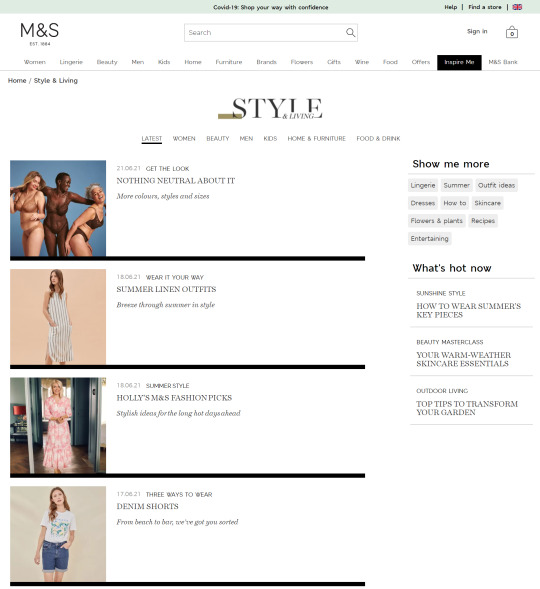
People often look for inspiration when they’re shopping, and these pages provide an effective way to add more internal links to category and product pages. But relying on this approach is one-dimensional, given that these deeper content pages tend to have lower PageRank. An extensive amount of time and effort will, therefore, be required to achieve the desired result.
In comparison, Product Listing Pages usually target broader search terms, and faceted navigations typically exist as passive functions. This is because they’re often blocked from crawlers, making them devoid of any SEO value. Waterstones (a well-known British bookstore) is one retailer that applies this rule for their on-page filters:
In this particular example, I’ve applied a filter to only show me books for 5 – 8 year olds, but the appended URL (https://ift.tt/3xrpOJS) is blocked in the robots.txt file. This is going to prevent such pages from being served in the SERPs despite them having the potential to meet specific customer needs. This shows that there can be a fundamental disconnect in matching customer intent to the pages we’re providing them in the organic results.
From the diagram below, we can see how editorial content typically focuses on the “awareness” and “interest” stages, whilst Product Listing Pages tend to be more in line with the “consideration” and “purchase” phases:
Serving the right content to users throughout their buying journey is pivotal to success. For many retailers, competitors are continuing to prioritize broader, high-volume keywords in saturated markets. They’re targeting the same terms to secure a proportion of the same search traffic. This is a very challenging prospect to face, and without carving out a gap in the marketplace, they won’t necessarily deliver the results they seek to secure. Likewise, relying on informational guides to target long-tail keywords means that you’re missing a large percentage of users who have very specific buying requirements. Yes, they’re ready to make a purchase!
By shifting your focus to address your customer’s real needs and expectations, you’ll be able to deliver a satisfying, frictionless experience at every interaction and all the way through to that final purchase.
The solution
Step 1: Conduct long-tail keyword research
Build a really comprehensive view of your potential customers by harnessing data from a variety of sources, including:
a) Keyword research tools like Moz, Google Keyword Planner, and Answer The Public.
b) The SERPs — get inspiration from the auto-suggest results, People Also Ask, and the related search links at the bottom of the page.
c) Competitor activity — aside from using SEO monitoring software, you can use a data mining extension tool like Scraper, which will extract faceted options directly from competitor Product Listing Pages. These tools are often free to download and allow you to quickly transfer product categories.
d) Your Google Search Console, Analytics, and PPC accounts to determine which keywords and URLs are securing the highest number of visits and web conversions. Internal search data can also give you great consumer insights.
e) Speak to your merchandising team to understand product demands and fulfillment capabilities.
Step 2: Group into meaningful sub-topics
Once you’ve collated all this information into a spreadsheet, you’ll be able to discover long-tail, consideration-orientated keywords. While individually they may not boast huge monthly search estimates, they can collectively highlight where purchase intentions can be better fulfilled.
To help illustrate this point, we can look at a small subset of lingerie keywords and the facets the searches represent:
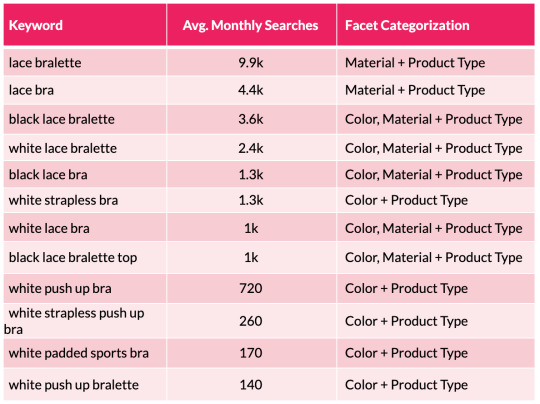
From the table above we can quickly see a pattern emerging with color and material variations appearing across the search terms. We can then substantiate this information with session and revenue estimates with the use of a recognized CTR model. This enables us to help forecast the potential organic uplift and quantify the size of the prize for a number of different scenarios that are on offer from each new facet combination. This may include estimations for securing position 10, 7, 5, 3 and 1 in Google.
One thing to note here is that it’s worth excluding synonyms, as they will falsely inflate your calculations. An example here would be to exclude “storage drawers” (22.2k monthly searchers) when reviewing the performance for “chest of drawers” (201k m/s). Including both variants will cause a false positive result and will lead you to draw incorrect conclusions.
Step 3: Dig deeper into broader terms around offers, ratings, and price
These product filters are found in the “Sort” dropdown box and, from my experience, these are set to “noindex” from the outset as they simply allow users to re-order page results. Certainly, content management systems like Shopify and Shopware have this as a default.
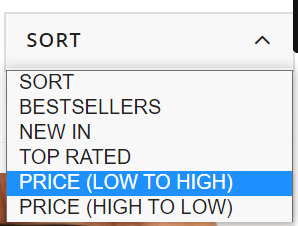
This makes sense since their purpose is to allow visitors to simply sort or narrow page content rather than offering alternative results and additional value (which is offered through faceted navigation). As such, filter typically produce duplicate results which should not be discoverable beyond the immediate moment. But this hard-and-fast rule doesn’t always apply perfectly in the real world. This is why we need to look at our individual industries and understand what’s important to our unique set of customers.
If we look at the world of gifting, we often see people shopping with a particular budget in mind. Therefore, terms like “birthday gift under £20” (40 m/s) or “Secret Santa gift under £10” (2.9k m/s) are reasonably common, and opening up relevant listing pages could be useful for shoppers.
Step 4: The technical steps
Facet taxonomies are hugely complex and the number of attributes that can be strung together increases with the size of the domain. We, therefore, need to carefully manage the flood gates and mitigate against any potential risks including crawl inefficiencies and link equity dilution.
We can do this by:
1. Avoiding thin/doorway pages by regularly re-assessing your product offering. For instance, you may consider there to be little value in creating a new listings page if you’re selling a very small range of low price point products. In this case, you may decide against opening up an additional Product Listing Page when you sell as few as 10 eligible products. However, this is not a fixed rule, so it’s quite possible that your criteria may be lower for particular product lines. Either way, these numbers will change over time. Consider seasonal trends, when new collections are launched, and when they become discontinued. Setting up a product retirement strategy to manage expired products and categories at scale in parallel with this step is also highly recommended.
2. Prevent content cannibalization by arranging selected facets according to their value and significance. “Size” is very important for some electrical goods like TVs, laptops, and cameras, but is less so for beauty accessories or vacuum cleaners. You must also make sure page content is distinctive and reflects the focus of your chosen facet(s). Refer to step 5 for more details.
3. Follow the sequence in which adjectives and facets are typically selected by your customers. This can vary depending on where your audience lives. So, whilst products generally have five or more distinguishable features, English vernacular determines that we use more than four adjectives (e.g. size + color + material + shape) to describe something.
4. Control the controllables by dealing with overlapping variations. This typically occurs when multiples co-exist and each exhibits good search metrics. For instance, it’s reasonable for someone to simultaneously look for several color and/or fabric combinations in the different ways below.
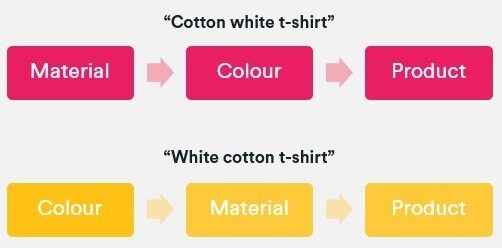
When this situation occurs, we should follow the same linguistic rules as above and choose a preferred sequence. In this case, it would be color + material + product type.
In comparison to the noindex tag suggested for on-page filters you should canonicalize unnecessary facets to their parent page (remembering that this is merely a hint and not a directive). This will enable you to control how crawlers deal with highly comparable result pages and will, therefore, help to prevent your site from being demoted in the SERPs. Dynamic search parameters should continue to be defined with a “noindex, nofollow” meta robots tag, disallowed in the robots.txt file, and configured through Google’s URL parameter tool (within your Search Console account) to tell crawlers the purpose of your parameters and how you would like them to be treated. This is a helpful guide on parameter handling for Googlebots, but bear in mind that this last tip won’t influence how Bing or Yahoo user-agents interpret these pages.
5. Open your facets in phases and cultivate it into a test-and-learn process. This will enable you to identify issues a lot sooner and implement facet-wide solutions in a timely manner. Without having to unravel these additional layers of complexity, problems such as crawl inefficiencies, PageRank dilution, or excessive indexation can be swiftly resolved.
To show you what this could look like, I’ve provided a phasing plan that was created for one of our e-commerce clients. Our research showed a significant SEO opportunity for opening up some of the facets and filters: potential +£263Kpcm for the “colour + type” facet (UK):
What’s more, when we extended our forecast to include other facet combinations, we calculated an additional revenue opportunity of up to +£207K/pcm (before filtering out combinations with no products offering).
Step 5: Optimize your facet URLs
Optimize your new facet category URLs to establish relevancy for your selected search terms. The key on-page elements to focus on include:
URL
Page title
Breadcrumb anchor texts
H tags
Content snippets (e.g. introductory text and FAQ copy)
Image ALT texts
Product names
Link out to similar facet category pages (i.e. via a “You May Also Like” feature box)
David’s Bridal is a good example of a retailer that has done this well. Looking back at the ‘Long Sleeve Wedding Dress’ Product Listing Page, we can see that they’ve curated unique content and followed fundamental optimization tactics on the landing page in a way that feels helpful to the user.
URL: davidsbridal.com/long-sleeve-wedding-dresses
Page Title: Long Sleeve Wedding Dresses & Gowns | David's Bridal
Meta Description: Do you dream of wearing a long sleeve wedding dress on your big day? Shop David's Bridal wide variety of wedding gowns with sleeves in lace & other designs!
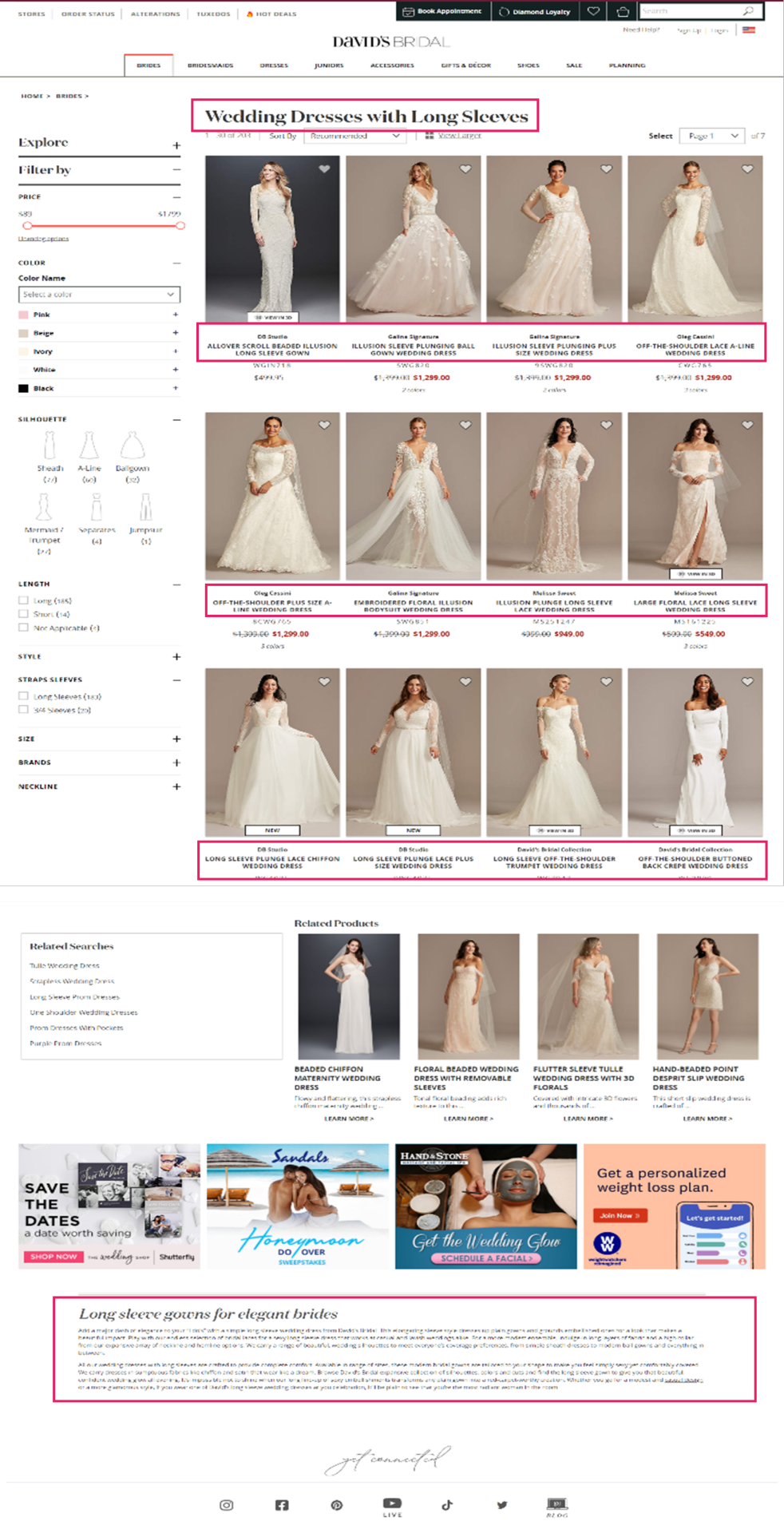
6. Provide accessibility and build page authority
Once you’ve opened up your new facet Product Listing Pages, you need to begin cultivating link equity towards them. This will ensure that they don’t exist as orphan URLs with no PageRank:
Ensure they’re referenced in your product XML sitemap.
If you have one feature per facet URL, then add them to your faceted navigation across CLP and Product Listing Page pages.
If you have two or more features per facet URL, then create a “Popular Searches” or “Related Searches” option within your CLPs.
Utilize your mega menu to showcase your new category landing pages. This will not only allow you to direct a large proportion of link equity, but it will also secure the highest click-through rate amongst your visitors.
Integrate your editorial strategy by creating engaging content with in-copy links. Think about how you can use descriptive long-tail anchor text about the Product Listing Page you want to link to rather than relying on “click here” or “see more”.
Connect to them via href links so you’re not solely relying on links from the main navigation or content hyperlinks. As this is difficult to do at scale, it can be done through modules such as “related categories”, “other subcategories”, “related products”, etc.
Devise strategic outreach campaigns that will secure quality, external backlinks to them.
Implementing this holistic and robust strategy will help you to secure exponential growth from your new commercial landing pages.
Conclusion
There is a great deal of organic opportunity that exists within your faceted navigation if you begin to leverage mid- and long-tail search terms.
Seek out the opportunity from extended keyword research and competitor analysis before deciding which variants fulfill consumer demands and deliver optimal organic sessions and onsite conversions. Configure a single faceted URL for each opportunity and open them up for crawl and indexation. Ensure PageRank is distributed to them (both internally and externally) and develop your landing page content in line with quality optimization practices. This approach will help you to avoid having crawl inefficiencies, over indexation, cannibalization, or having thin doorway pages. In turn, your website will be better suited to attract highly-targeted users and guide them down the purchase funnel.
Maximizing UX and reducing reliance on other marketing channels means that your faceted navigation can truly deliver organic ROI. We have seen this work for our clients.
0 notes
Text
Fulfill Untapped Customer Demands Through Your Faceted Navigation
Faceted navigation allows customers to narrow down search results based on specific product attributes. They typically exist on Product Listing Pages (PLPs) and are a great way to help users intuitively discover products but managing this filtering system is a common SEO challenge. Crawling and indexation need to be controlled.
However, if we look beyond their inherent functionality, facets can offer us considerable potential. By centering your secondary navigation on long-tail keyword opportunities, you’ll be able to strategically utilize consumer intent, secure additional web conversions, and boost revenue levels.
Match consumer intent with long-tail search queries
Having an established brand and a solid domain backlink profile won’t guarantee success. This is great news for smaller brands, as industry giants aren’t necessarily going to win at this game.
If we search for “long sleeve wedding dresses”, we can see how David’s Bridal’s optimized facet page (Domain Authority: 67/100, Page Authority: 47 / 100) has obtained the top ranking position, while Nordstrom’s result (Domain Authority: 87/100, Page Authority: 39/100) appears in the third position for this particular query. We’ll take a look at what makes this page so effective later.
When looking at how we can optimize faceted navigations, it’s important to recognize that product attributes convey consumer needs and aspirations. If, for example, I’m looking for a wedding dress, then I may tailor my search by the color, fabric, neckline shape, and the sleeve length.
According to the search demand curve, long-tail queries account for up to 70% of all organic searches. They are highly targeted queries that offer big traffic-driving opportunities.
In the last few years, we’ve seen a big shift in the industry towards capitalizing this intent with long-form content. Blog articles and style guides have become the go-to methods for many to capture these visitors, as we can see from the examples taken from Marks & Spencers’ "Inspire Me" section:
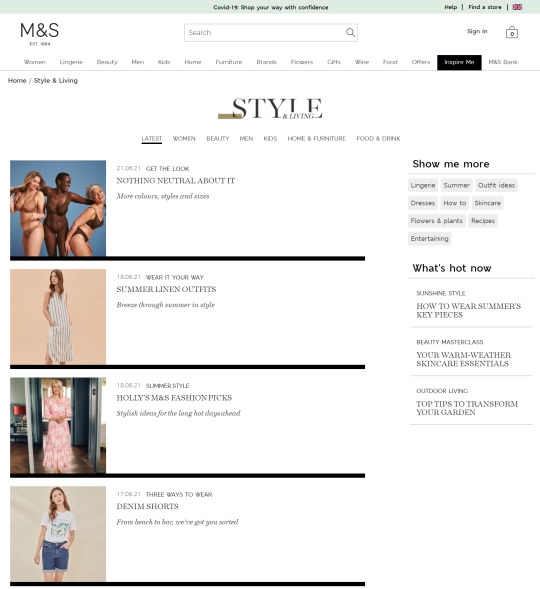
People often look for inspiration when they’re shopping, and these pages provide an effective way to add more internal links to category and product pages. But relying on this approach is one-dimensional, given that these deeper content pages tend to have lower PageRank. An extensive amount of time and effort will, therefore, be required to achieve the desired result.
In comparison, Product Listing Pages usually target broader search terms, and faceted navigations typically exist as passive functions. This is because they’re often blocked from crawlers, making them devoid of any SEO value. Waterstones (a well-known British bookstore) is one retailer that applies this rule for their on-page filters:
In this particular example, I’ve applied a filter to only show me books for 5 – 8 year olds, but the appended URL (https://ift.tt/3xrpOJS) is blocked in the robots.txt file. This is going to prevent such pages from being served in the SERPs despite them having the potential to meet specific customer needs. This shows that there can be a fundamental disconnect in matching customer intent to the pages we’re providing them in the organic results.
From the diagram below, we can see how editorial content typically focuses on the “awareness” and “interest” stages, whilst Product Listing Pages tend to be more in line with the “consideration” and “purchase” phases:
Serving the right content to users throughout their buying journey is pivotal to success. For many retailers, competitors are continuing to prioritize broader, high-volume keywords in saturated markets. They’re targeting the same terms to secure a proportion of the same search traffic. This is a very challenging prospect to face, and without carving out a gap in the marketplace, they won’t necessarily deliver the results they seek to secure. Likewise, relying on informational guides to target long-tail keywords means that you’re missing a large percentage of users who have very specific buying requirements. Yes, they’re ready to make a purchase!
By shifting your focus to address your customer’s real needs and expectations, you’ll be able to deliver a satisfying, frictionless experience at every interaction and all the way through to that final purchase.
The solution
Step 1: Conduct long-tail keyword research
Build a really comprehensive view of your potential customers by harnessing data from a variety of sources, including:
a) Keyword research tools like Moz, Google Keyword Planner, and Answer The Public.
b) The SERPs — get inspiration from the auto-suggest results, People Also Ask, and the related search links at the bottom of the page.
c) Competitor activity — aside from using SEO monitoring software, you can use a data mining extension tool like Scraper, which will extract faceted options directly from competitor Product Listing Pages. These tools are often free to download and allow you to quickly transfer product categories.
d) Your Google Search Console, Analytics, and PPC accounts to determine which keywords and URLs are securing the highest number of visits and web conversions. Internal search data can also give you great consumer insights.
e) Speak to your merchandising team to understand product demands and fulfillment capabilities.
Step 2: Group into meaningful sub-topics
Once you’ve collated all this information into a spreadsheet, you’ll be able to discover long-tail, consideration-orientated keywords. While individually they may not boast huge monthly search estimates, they can collectively highlight where purchase intentions can be better fulfilled.
To help illustrate this point, we can look at a small subset of lingerie keywords and the facets the searches represent:
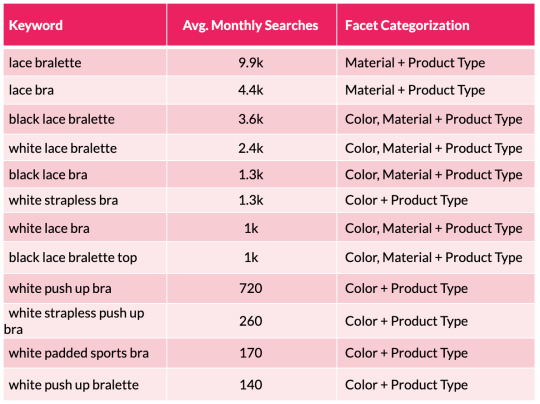
From the table above we can quickly see a pattern emerging with color and material variations appearing across the search terms. We can then substantiate this information with session and revenue estimates with the use of a recognized CTR model. This enables us to help forecast the potential organic uplift and quantify the size of the prize for a number of different scenarios that are on offer from each new facet combination. This may include estimations for securing position 10, 7, 5, 3 and 1 in Google.
One thing to note here is that it’s worth excluding synonyms, as they will falsely inflate your calculations. An example here would be to exclude “storage drawers” (22.2k monthly searchers) when reviewing the performance for “chest of drawers” (201k m/s). Including both variants will cause a false positive result and will lead you to draw incorrect conclusions.
Step 3: Dig deeper into broader terms around offers, ratings, and price
These product filters are found in the “Sort” dropdown box and, from my experience, these are set to “noindex” from the outset as they simply allow users to re-order page results. Certainly, content management systems like Shopify and Shopware have this as a default.
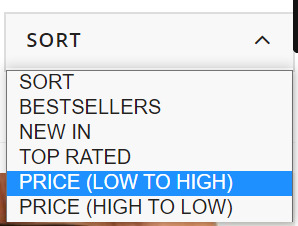
This makes sense since their purpose is to allow visitors to simply sort or narrow page content rather than offering alternative results and additional value (which is offered through faceted navigation). As such, filter typically produce duplicate results which should not be discoverable beyond the immediate moment. But this hard-and-fast rule doesn’t always apply perfectly in the real world. This is why we need to look at our individual industries and understand what’s important to our unique set of customers.
If we look at the world of gifting, we often see people shopping with a particular budget in mind. Therefore, terms like “birthday gift under £20” (40 m/s) or “Secret Santa gift under £10” (2.9k m/s) are reasonably common, and opening up relevant listing pages could be useful for shoppers.
Step 4: The technical steps
Facet taxonomies are hugely complex and the number of attributes that can be strung together increases with the size of the domain. We, therefore, need to carefully manage the flood gates and mitigate against any potential risks including crawl inefficiencies and link equity dilution.
We can do this by:
1. Avoiding thin/doorway pages by regularly re-assessing your product offering. For instance, you may consider there to be little value in creating a new listings page if you’re selling a very small range of low price point products. In this case, you may decide against opening up an additional Product Listing Page when you sell as few as 10 eligible products. However, this is not a fixed rule, so it’s quite possible that your criteria may be lower for particular product lines. Either way, these numbers will change over time. Consider seasonal trends, when new collections are launched, and when they become discontinued. Setting up a product retirement strategy to manage expired products and categories at scale in parallel with this step is also highly recommended.
2. Prevent content cannibalization by arranging selected facets according to their value and significance. “Size” is very important for some electrical goods like TVs, laptops, and cameras, but is less so for beauty accessories or vacuum cleaners. You must also make sure page content is distinctive and reflects the focus of your chosen facet(s). Refer to step 5 for more details.
3. Follow the sequence in which adjectives and facets are typically selected by your customers. This can vary depending on where your audience lives. So, whilst products generally have five or more distinguishable features, English vernacular determines that we use more than four adjectives (e.g. size + color + material + shape) to describe something.
4. Control the controllables by dealing with overlapping variations. This typically occurs when multiples co-exist and each exhibits good search metrics. For instance, it’s reasonable for someone to simultaneously look for several color and/or fabric combinations in the different ways below.
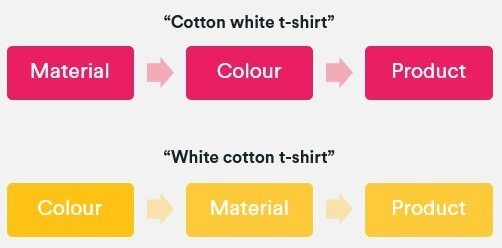
When this situation occurs, we should follow the same linguistic rules as above and choose a preferred sequence. In this case, it would be color + material + product type.
In comparison to the noindex tag suggested for on-page filters you should canonicalize unnecessary facets to their parent page (remembering that this is merely a hint and not a directive). This will enable you to control how crawlers deal with highly comparable result pages and will, therefore, help to prevent your site from being demoted in the SERPs. Dynamic search parameters should continue to be defined with a “noindex, nofollow” meta robots tag, disallowed in the robots.txt file, and configured through Google’s URL parameter tool (within your Search Console account) to tell crawlers the purpose of your parameters and how you would like them to be treated. This is a helpful guide on parameter handling for Googlebots, but bear in mind that this last tip won’t influence how Bing or Yahoo user-agents interpret these pages.
5. Open your facets in phases and cultivate it into a test-and-learn process. This will enable you to identify issues a lot sooner and implement facet-wide solutions in a timely manner. Without having to unravel these additional layers of complexity, problems such as crawl inefficiencies, PageRank dilution, or excessive indexation can be swiftly resolved.
To show you what this could look like, I’ve provided a phasing plan that was created for one of our e-commerce clients. Our research showed a significant SEO opportunity for opening up some of the facets and filters: potential +£263Kpcm for the “colour + type” facet (UK):
What’s more, when we extended our forecast to include other facet combinations, we calculated an additional revenue opportunity of up to +£207K/pcm (before filtering out combinations with no products offering).
Step 5: Optimize your facet URLs
Optimize your new facet category URLs to establish relevancy for your selected search terms. The key on-page elements to focus on include:
URL
Page title
Breadcrumb anchor texts
H tags
Content snippets (e.g. introductory text and FAQ copy)
Image ALT texts
Product names
Link out to similar facet category pages (i.e. via a “You May Also Like” feature box)
David’s Bridal is a good example of a retailer that has done this well. Looking back at the ‘Long Sleeve Wedding Dress’ Product Listing Page, we can see that they’ve curated unique content and followed fundamental optimization tactics on the landing page in a way that feels helpful to the user.
URL: davidsbridal.com/long-sleeve-wedding-dresses
Page Title: Long Sleeve Wedding Dresses & Gowns | David's Bridal
Meta Description: Do you dream of wearing a long sleeve wedding dress on your big day? Shop David's Bridal wide variety of wedding gowns with sleeves in lace & other designs!
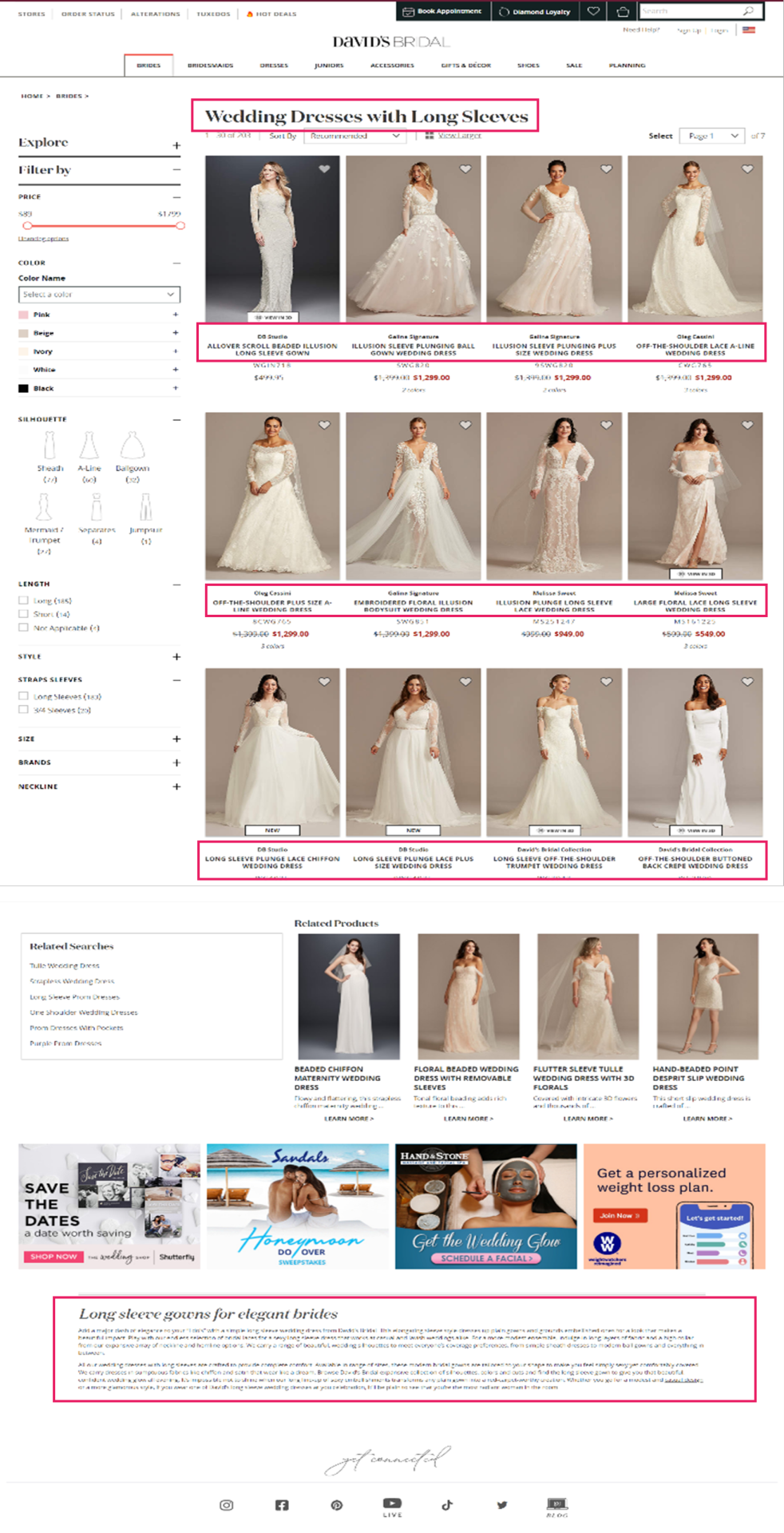
6. Provide accessibility and build page authority
Once you’ve opened up your new facet Product Listing Pages, you need to begin cultivating link equity towards them. This will ensure that they don’t exist as orphan URLs with no PageRank:
Ensure they’re referenced in your product XML sitemap.
If you have one feature per facet URL, then add them to your faceted navigation across CLP and Product Listing Page pages.
If you have two or more features per facet URL, then create a “Popular Searches” or “Related Searches” option within your CLPs.
Utilize your mega menu to showcase your new category landing pages. This will not only allow you to direct a large proportion of link equity, but it will also secure the highest click-through rate amongst your visitors.
Integrate your editorial strategy by creating engaging content with in-copy links. Think about how you can use descriptive long-tail anchor text about the Product Listing Page you want to link to rather than relying on “click here” or “see more”.
Connect to them via href links so you’re not solely relying on links from the main navigation or content hyperlinks. As this is difficult to do at scale, it can be done through modules such as “related categories”, “other subcategories”, “related products”, etc.
Devise strategic outreach campaigns that will secure quality, external backlinks to them.
Implementing this holistic and robust strategy will help you to secure exponential growth from your new commercial landing pages.
Conclusion
There is a great deal of organic opportunity that exists within your faceted navigation if you begin to leverage mid- and long-tail search terms.
Seek out the opportunity from extended keyword research and competitor analysis before deciding which variants fulfill consumer demands and deliver optimal organic sessions and onsite conversions. Configure a single faceted URL for each opportunity and open them up for crawl and indexation. Ensure PageRank is distributed to them (both internally and externally) and develop your landing page content in line with quality optimization practices. This approach will help you to avoid having crawl inefficiencies, over indexation, cannibalization, or having thin doorway pages. In turn, your website will be better suited to attract highly-targeted users and guide them down the purchase funnel.
Maximizing UX and reducing reliance on other marketing channels means that your faceted navigation can truly deliver organic ROI. We have seen this work for our clients.
0 notes
Text
Fulfill Untapped Customer Demands Through Your Faceted Navigation
Faceted navigation allows customers to narrow down search results based on specific product attributes. They typically exist on Product Listing Pages (PLPs) and are a great way to help users intuitively discover products but managing this filtering system is a common SEO challenge. Crawling and indexation need to be controlled.
However, if we look beyond their inherent functionality, facets can offer us considerable potential. By centering your secondary navigation on long-tail keyword opportunities, you’ll be able to strategically utilize consumer intent, secure additional web conversions, and boost revenue levels.
Match consumer intent with long-tail search queries
Having an established brand and a solid domain backlink profile won’t guarantee success. This is great news for smaller brands, as industry giants aren’t necessarily going to win at this game.
If we search for “long sleeve wedding dresses”, we can see how David’s Bridal’s optimized facet page (Domain Authority: 67/100, Page Authority: 47 / 100) has obtained the top ranking position, while Nordstrom’s result (Domain Authority: 87/100, Page Authority: 39/100) appears in the third position for this particular query. We’ll take a look at what makes this page so effective later.
When looking at how we can optimize faceted navigations, it’s important to recognize that product attributes convey consumer needs and aspirations. If, for example, I’m looking for a wedding dress, then I may tailor my search by the color, fabric, neckline shape, and the sleeve length.
According to the search demand curve, long-tail queries account for up to 70% of all organic searches. They are highly targeted queries that offer big traffic-driving opportunities.
In the last few years, we’ve seen a big shift in the industry towards capitalizing this intent with long-form content. Blog articles and style guides have become the go-to methods for many to capture these visitors, as we can see from the examples taken from Marks & Spencers’ "Inspire Me" section:
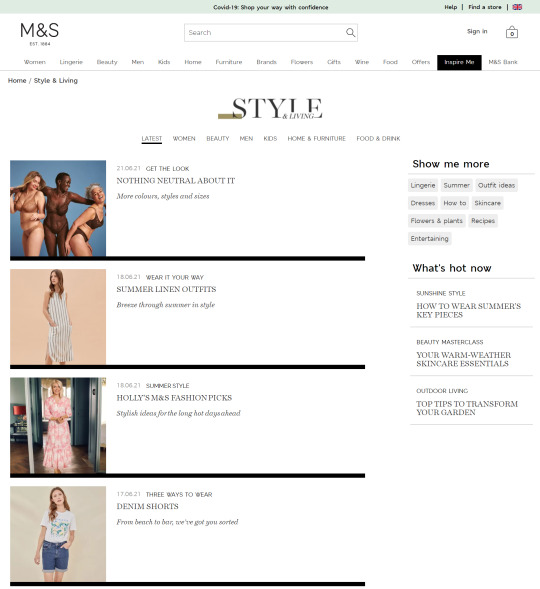
People often look for inspiration when they’re shopping, and these pages provide an effective way to add more internal links to category and product pages. But relying on this approach is one-dimensional, given that these deeper content pages tend to have lower PageRank. An extensive amount of time and effort will, therefore, be required to achieve the desired result.
In comparison, Product Listing Pages usually target broader search terms, and faceted navigations typically exist as passive functions. This is because they’re often blocked from crawlers, making them devoid of any SEO value. Waterstones (a well-known British bookstore) is one retailer that applies this rule for their on-page filters:
In this particular example, I’ve applied a filter to only show me books for 5 – 8 year olds, but the appended URL (https://ift.tt/3xrpOJS) is blocked in the robots.txt file. This is going to prevent such pages from being served in the SERPs despite them having the potential to meet specific customer needs. This shows that there can be a fundamental disconnect in matching customer intent to the pages we’re providing them in the organic results.
From the diagram below, we can see how editorial content typically focuses on the “awareness” and “interest” stages, whilst Product Listing Pages tend to be more in line with the “consideration” and “purchase” phases:
Serving the right content to users throughout their buying journey is pivotal to success. For many retailers, competitors are continuing to prioritize broader, high-volume keywords in saturated markets. They’re targeting the same terms to secure a proportion of the same search traffic. This is a very challenging prospect to face, and without carving out a gap in the marketplace, they won’t necessarily deliver the results they seek to secure. Likewise, relying on informational guides to target long-tail keywords means that you’re missing a large percentage of users who have very specific buying requirements. Yes, they’re ready to make a purchase!
By shifting your focus to address your customer’s real needs and expectations, you’ll be able to deliver a satisfying, frictionless experience at every interaction and all the way through to that final purchase.
The solution
Step 1: Conduct long-tail keyword research
Build a really comprehensive view of your potential customers by harnessing data from a variety of sources, including:
a) Keyword research tools like Moz, Google Keyword Planner, and Answer The Public.
b) The SERPs — get inspiration from the auto-suggest results, People Also Ask, and the related search links at the bottom of the page.
c) Competitor activity — aside from using SEO monitoring software, you can use a data mining extension tool like Scraper, which will extract faceted options directly from competitor Product Listing Pages. These tools are often free to download and allow you to quickly transfer product categories.
d) Your Google Search Console, Analytics, and PPC accounts to determine which keywords and URLs are securing the highest number of visits and web conversions. Internal search data can also give you great consumer insights.
e) Speak to your merchandising team to understand product demands and fulfillment capabilities.
Step 2: Group into meaningful sub-topics
Once you’ve collated all this information into a spreadsheet, you’ll be able to discover long-tail, consideration-orientated keywords. While individually they may not boast huge monthly search estimates, they can collectively highlight where purchase intentions can be better fulfilled.
To help illustrate this point, we can look at a small subset of lingerie keywords and the facets the searches represent:
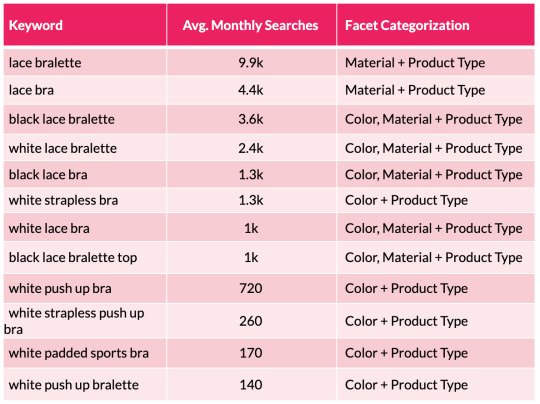
From the table above we can quickly see a pattern emerging with color and material variations appearing across the search terms. We can then substantiate this information with session and revenue estimates with the use of a recognized CTR model. This enables us to help forecast the potential organic uplift and quantify the size of the prize for a number of different scenarios that are on offer from each new facet combination. This may include estimations for securing position 10, 7, 5, 3 and 1 in Google.
One thing to note here is that it’s worth excluding synonyms, as they will falsely inflate your calculations. An example here would be to exclude “storage drawers” (22.2k monthly searchers) when reviewing the performance for “chest of drawers” (201k m/s). Including both variants will cause a false positive result and will lead you to draw incorrect conclusions.
Step 3: Dig deeper into broader terms around offers, ratings, and price
These product filters are found in the “Sort” dropdown box and, from my experience, these are set to “noindex” from the outset as they simply allow users to re-order page results. Certainly, content management systems like Shopify and Shopware have this as a default.
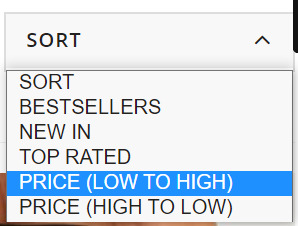
This makes sense since their purpose is to allow visitors to simply sort or narrow page content rather than offering alternative results and additional value (which is offered through faceted navigation). As such, filter typically produce duplicate results which should not be discoverable beyond the immediate moment. But this hard-and-fast rule doesn’t always apply perfectly in the real world. This is why we need to look at our individual industries and understand what’s important to our unique set of customers.
If we look at the world of gifting, we often see people shopping with a particular budget in mind. Therefore, terms like “birthday gift under £20” (40 m/s) or “Secret Santa gift under £10” (2.9k m/s) are reasonably common, and opening up relevant listing pages could be useful for shoppers.
Step 4: The technical steps
Facet taxonomies are hugely complex and the number of attributes that can be strung together increases with the size of the domain. We, therefore, need to carefully manage the flood gates and mitigate against any potential risks including crawl inefficiencies and link equity dilution.
We can do this by:
1. Avoiding thin/doorway pages by regularly re-assessing your product offering. For instance, you may consider there to be little value in creating a new listings page if you’re selling a very small range of low price point products. In this case, you may decide against opening up an additional Product Listing Page when you sell as few as 10 eligible products. However, this is not a fixed rule, so it’s quite possible that your criteria may be lower for particular product lines. Either way, these numbers will change over time. Consider seasonal trends, when new collections are launched, and when they become discontinued. Setting up a product retirement strategy to manage expired products and categories at scale in parallel with this step is also highly recommended.
2. Prevent content cannibalization by arranging selected facets according to their value and significance. “Size” is very important for some electrical goods like TVs, laptops, and cameras, but is less so for beauty accessories or vacuum cleaners. You must also make sure page content is distinctive and reflects the focus of your chosen facet(s). Refer to step 5 for more details.
3. Follow the sequence in which adjectives and facets are typically selected by your customers. This can vary depending on where your audience lives. So, whilst products generally have five or more distinguishable features, English vernacular determines that we use more than four adjectives (e.g. size + color + material + shape) to describe something.
4. Control the controllables by dealing with overlapping variations. This typically occurs when multiples co-exist and each exhibits good search metrics. For instance, it’s reasonable for someone to simultaneously look for several color and/or fabric combinations in the different ways below.

When this situation occurs, we should follow the same linguistic rules as above and choose a preferred sequence. In this case, it would be color + material + product type.
In comparison to the noindex tag suggested for on-page filters you should canonicalize unnecessary facets to their parent page (remembering that this is merely a hint and not a directive). This will enable you to control how crawlers deal with highly comparable result pages and will, therefore, help to prevent your site from being demoted in the SERPs. Dynamic search parameters should continue to be defined with a “noindex, nofollow” meta robots tag, disallowed in the robots.txt file, and configured through Google’s URL parameter tool (within your Search Console account) to tell crawlers the purpose of your parameters and how you would like them to be treated. This is a helpful guide on parameter handling for Googlebots, but bear in mind that this last tip won’t influence how Bing or Yahoo user-agents interpret these pages.
5. Open your facets in phases and cultivate it into a test-and-learn process. This will enable you to identify issues a lot sooner and implement facet-wide solutions in a timely manner. Without having to unravel these additional layers of complexity, problems such as crawl inefficiencies, PageRank dilution, or excessive indexation can be swiftly resolved.
To show you what this could look like, I’ve provided a phasing plan that was created for one of our e-commerce clients. Our research showed a significant SEO opportunity for opening up some of the facets and filters: potential +£263Kpcm for the “colour + type” facet (UK):
What’s more, when we extended our forecast to include other facet combinations, we calculated an additional revenue opportunity of up to +£207K/pcm (before filtering out combinations with no products offering).
Step 5: Optimize your facet URLs
Optimize your new facet category URLs to establish relevancy for your selected search terms. The key on-page elements to focus on include:
URL
Page title
Breadcrumb anchor texts
H tags
Content snippets (e.g. introductory text and FAQ copy)
Image ALT texts
Product names
Link out to similar facet category pages (i.e. via a “You May Also Like” feature box)
David’s Bridal is a good example of a retailer that has done this well. Looking back at the ‘Long Sleeve Wedding Dress’ Product Listing Page, we can see that they’ve curated unique content and followed fundamental optimization tactics on the landing page in a way that feels helpful to the user.
URL: davidsbridal.com/long-sleeve-wedding-dresses
Page Title: Long Sleeve Wedding Dresses & Gowns | David's Bridal
Meta Description: Do you dream of wearing a long sleeve wedding dress on your big day? Shop David's Bridal wide variety of wedding gowns with sleeves in lace & other designs!
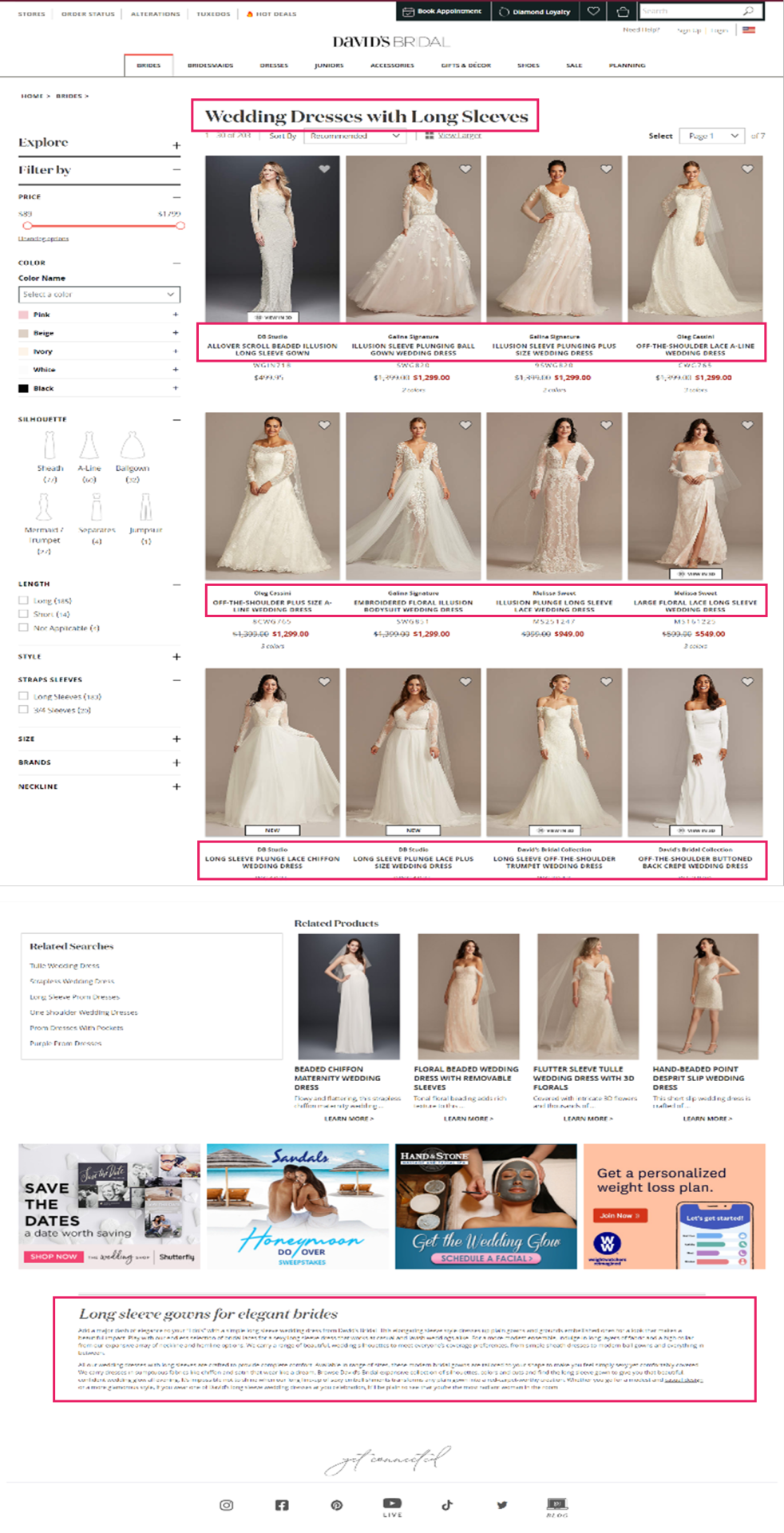
6. Provide accessibility and build page authority
Once you’ve opened up your new facet Product Listing Pages, you need to begin cultivating link equity towards them. This will ensure that they don’t exist as orphan URLs with no PageRank:
Ensure they’re referenced in your product XML sitemap.
If you have one feature per facet URL, then add them to your faceted navigation across CLP and Product Listing Page pages.
If you have two or more features per facet URL, then create a “Popular Searches” or “Related Searches” option within your CLPs.
Utilize your mega menu to showcase your new category landing pages. This will not only allow you to direct a large proportion of link equity, but it will also secure the highest click-through rate amongst your visitors.
Integrate your editorial strategy by creating engaging content with in-copy links. Think about how you can use descriptive long-tail anchor text about the Product Listing Page you want to link to rather than relying on “click here” or “see more”.
Connect to them via href links so you’re not solely relying on links from the main navigation or content hyperlinks. As this is difficult to do at scale, it can be done through modules such as “related categories”, “other subcategories”, “related products”, etc.
Devise strategic outreach campaigns that will secure quality, external backlinks to them.
Implementing this holistic and robust strategy will help you to secure exponential growth from your new commercial landing pages.
Conclusion
There is a great deal of organic opportunity that exists within your faceted navigation if you begin to leverage mid- and long-tail search terms.
Seek out the opportunity from extended keyword research and competitor analysis before deciding which variants fulfill consumer demands and deliver optimal organic sessions and onsite conversions. Configure a single faceted URL for each opportunity and open them up for crawl and indexation. Ensure PageRank is distributed to them (both internally and externally) and develop your landing page content in line with quality optimization practices. This approach will help you to avoid having crawl inefficiencies, over indexation, cannibalization, or having thin doorway pages. In turn, your website will be better suited to attract highly-targeted users and guide them down the purchase funnel.
Maximizing UX and reducing reliance on other marketing channels means that your faceted navigation can truly deliver organic ROI. We have seen this work for our clients.
#túi_giấy_epacking_việt_nam #túi_giấy_epacking #in_túi_giấy_giá_rẻ #in_túi_giấy #epackingvietnam #tuigiayepacking
0 notes
Text
Fulfill Untapped Customer Demands Through Your Faceted Navigation
Faceted navigation allows customers to narrow down search results based on specific product attributes. They typically exist on Product Listing Pages (PLPs) and are a great way to help users intuitively discover products but managing this filtering system is a common SEO challenge. Crawling and indexation need to be controlled.
However, if we look beyond their inherent functionality, facets can offer us considerable potential. By centering your secondary navigation on long-tail keyword opportunities, you’ll be able to strategically utilize consumer intent, secure additional web conversions, and boost revenue levels.
Match consumer intent with long-tail search queries
Having an established brand and a solid domain backlink profile won’t guarantee success. This is great news for smaller brands, as industry giants aren’t necessarily going to win at this game.
If we search for “long sleeve wedding dresses”, we can see how David’s Bridal’s optimized facet page (Domain Authority: 67/100, Page Authority: 47 / 100) has obtained the top ranking position, while Nordstrom’s result (Domain Authority: 87/100, Page Authority: 39/100) appears in the third position for this particular query. We’ll take a look at what makes this page so effective later.
When looking at how we can optimize faceted navigations, it’s important to recognize that product attributes convey consumer needs and aspirations. If, for example, I’m looking for a wedding dress, then I may tailor my search by the color, fabric, neckline shape, and the sleeve length.
According to the search demand curve, long-tail queries account for up to 70% of all organic searches. They are highly targeted queries that offer big traffic-driving opportunities.
In the last few years, we’ve seen a big shift in the industry towards capitalizing this intent with long-form content. Blog articles and style guides have become the go-to methods for many to capture these visitors, as we can see from the examples taken from Marks & Spencers’ "Inspire Me" section:
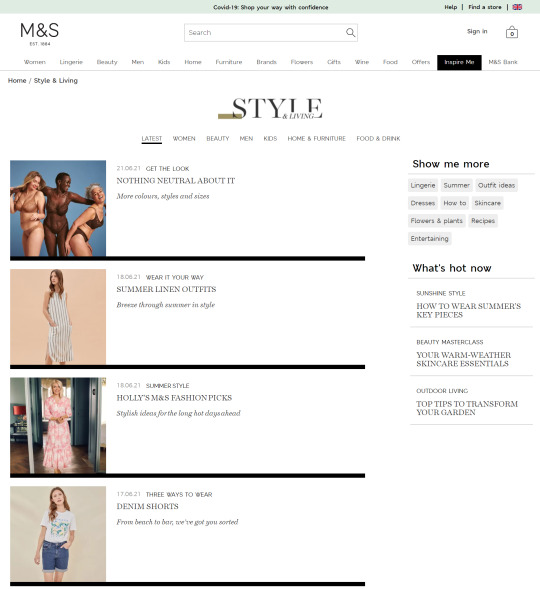
People often look for inspiration when they’re shopping, and these pages provide an effective way to add more internal links to category and product pages. But relying on this approach is one-dimensional, given that these deeper content pages tend to have lower PageRank. An extensive amount of time and effort will, therefore, be required to achieve the desired result.
In comparison, Product Listing Pages usually target broader search terms, and faceted navigations typically exist as passive functions. This is because they’re often blocked from crawlers, making them devoid of any SEO value. Waterstones (a well-known British bookstore) is one retailer that applies this rule for their on-page filters:
In this particular example, I’ve applied a filter to only show me books for 5 – 8 year olds, but the appended URL (https://www.waterstones.com/category/childrens-teenage/facet/498) is blocked in the robots.txt file. This is going to prevent such pages from being served in the SERPs despite them having the potential to meet specific customer needs. This shows that there can be a fundamental disconnect in matching customer intent to the pages we’re providing them in the organic results.
From the diagram below, we can see how editorial content typically focuses on the “awareness” and “interest” stages, whilst Product Listing Pages tend to be more in line with the “consideration” and “purchase” phases:
Serving the right content to users throughout their buying journey is pivotal to success. For many retailers, competitors are continuing to prioritize broader, high-volume keywords in saturated markets. They’re targeting the same terms to secure a proportion of the same search traffic. This is a very challenging prospect to face, and without carving out a gap in the marketplace, they won’t necessarily deliver the results they seek to secure. Likewise, relying on informational guides to target long-tail keywords means that you’re missing a large percentage of users who have very specific buying requirements. Yes, they’re ready to make a purchase!
By shifting your focus to address your customer’s real needs and expectations, you’ll be able to deliver a satisfying, frictionless experience at every interaction and all the way through to that final purchase.
The solution
Step 1: Conduct long-tail keyword research
Build a really comprehensive view of your potential customers by harnessing data from a variety of sources, including:
a) Keyword research tools like Moz, Google Keyword Planner, and Answer The Public.
b) The SERPs — get inspiration from the auto-suggest results, People Also Ask, and the related search links at the bottom of the page.
c) Competitor activity — aside from using SEO monitoring software, you can use a data mining extension tool like Scraper, which will extract faceted options directly from competitor Product Listing Pages. These tools are often free to download and allow you to quickly transfer product categories.
d) Your Google Search Console, Analytics, and PPC accounts to determine which keywords and URLs are securing the highest number of visits and web conversions. Internal search data can also give you great consumer insights.
e) Speak to your merchandising team to understand product demands and fulfillment capabilities.
Step 2: Group into meaningful sub-topics
Once you’ve collated all this information into a spreadsheet, you’ll be able to discover long-tail, consideration-orientated keywords. While individually they may not boast huge monthly search estimates, they can collectively highlight where purchase intentions can be better fulfilled.
To help illustrate this point, we can look at a small subset of lingerie keywords and the facets the searches represent:
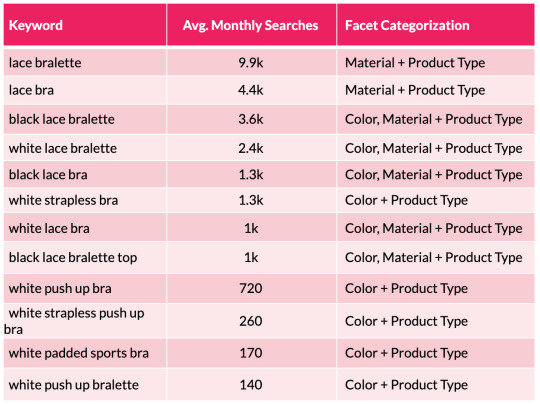
From the table above we can quickly see a pattern emerging with color and material variations appearing across the search terms. We can then substantiate this information with session and revenue estimates with the use of a recognized CTR model. This enables us to help forecast the potential organic uplift and quantify the size of the prize for a number of different scenarios that are on offer from each new facet combination. This may include estimations for securing position 10, 7, 5, 3 and 1 in Google.
One thing to note here is that it’s worth excluding synonyms, as they will falsely inflate your calculations. An example here would be to exclude “storage drawers” (22.2k monthly searchers) when reviewing the performance for “chest of drawers” (201k m/s). Including both variants will cause a false positive result and will lead you to draw incorrect conclusions.
Step 3: Dig deeper into broader terms around offers, ratings, and price
These product filters are found in the “Sort” dropdown box and, from my experience, these are set to “noindex” from the outset as they simply allow users to re-order page results. Certainly, content management systems like Shopify and Shopware have this as a default.
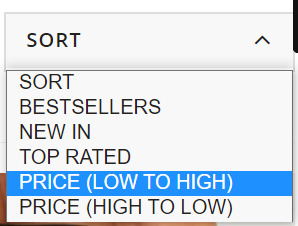
This makes sense since their purpose is to allow visitors to simply sort or narrow page content rather than offering alternative results and additional value (which is offered through faceted navigation). As such, filter typically produce duplicate results which should not be discoverable beyond the immediate moment. But this hard-and-fast rule doesn’t always apply perfectly in the real world. This is why we need to look at our individual industries and understand what’s important to our unique set of customers.
If we look at the world of gifting, we often see people shopping with a particular budget in mind. Therefore, terms like “birthday gift under £20” (40 m/s) or “Secret Santa gift under £10” (2.9k m/s) are reasonably common, and opening up relevant listing pages could be useful for shoppers.
Step 4: The technical steps
Facet taxonomies are hugely complex and the number of attributes that can be strung together increases with the size of the domain. We, therefore, need to carefully manage the flood gates and mitigate against any potential risks including crawl inefficiencies and link equity dilution.
We can do this by:
1. Avoiding thin/doorway pages by regularly re-assessing your product offering. For instance, you may consider there to be little value in creating a new listings page if you’re selling a very small range of low price point products. In this case, you may decide against opening up an additional Product Listing Page when you sell as few as 10 eligible products. However, this is not a fixed rule, so it’s quite possible that your criteria may be lower for particular product lines. Either way, these numbers will change over time. Consider seasonal trends, when new collections are launched, and when they become discontinued. Setting up a product retirement strategy to manage expired products and categories at scale in parallel with this step is also highly recommended.
2. Prevent content cannibalization by arranging selected facets according to their value and significance. “Size” is very important for some electrical goods like TVs, laptops, and cameras, but is less so for beauty accessories or vacuum cleaners. You must also make sure page content is distinctive and reflects the focus of your chosen facet(s). Refer to step 5 for more details.
3. Follow the sequence in which adjectives and facets are typically selected by your customers. This can vary depending on where your audience lives. So, whilst products generally have five or more distinguishable features, English vernacular determines that we use more than four adjectives (e.g. size + color + material + shape) to describe something.
4. Control the controllables by dealing with overlapping variations. This typically occurs when multiples co-exist and each exhibits good search metrics. For instance, it’s reasonable for someone to simultaneously look for several color and/or fabric combinations in the different ways below.
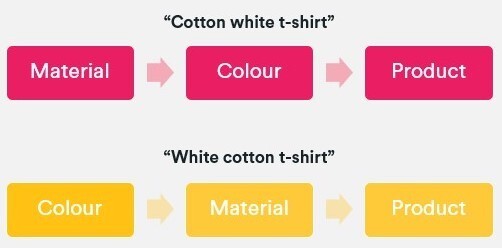
When this situation occurs, we should follow the same linguistic rules as above and choose a preferred sequence. In this case, it would be color + material + product type.
In comparison to the noindex tag suggested for on-page filters you should canonicalize unnecessary facets to their parent page (remembering that this is merely a hint and not a directive). This will enable you to control how crawlers deal with highly comparable result pages and will, therefore, help to prevent your site from being demoted in the SERPs. Dynamic search parameters should continue to be defined with a “noindex, nofollow” meta robots tag, disallowed in the robots.txt file, and configured through Google’s URL parameter tool (within your Search Console account) to tell crawlers the purpose of your parameters and how you would like them to be treated. This is a helpful guide on parameter handling for Googlebots, but bear in mind that this last tip won’t influence how Bing or Yahoo user-agents interpret these pages.
5. Open your facets in phases and cultivate it into a test-and-learn process. This will enable you to identify issues a lot sooner and implement facet-wide solutions in a timely manner. Without having to unravel these additional layers of complexity, problems such as crawl inefficiencies, PageRank dilution, or excessive indexation can be swiftly resolved.
To show you what this could look like, I’ve provided a phasing plan that was created for one of our e-commerce clients. Our research showed a significant SEO opportunity for opening up some of the facets and filters: potential +£263Kpcm for the “colour + type” facet (UK):
What’s more, when we extended our forecast to include other facet combinations, we calculated an additional revenue opportunity of up to +£207K/pcm (before filtering out combinations with no products offering).
Step 5: Optimize your facet URLs
Optimize your new facet category URLs to establish relevancy for your selected search terms. The key on-page elements to focus on include:
URL
Page title
Breadcrumb anchor texts
H tags
Content snippets (e.g. introductory text and FAQ copy)
Image ALT texts
Product names
Link out to similar facet category pages (i.e. via a “You May Also Like” feature box)
David’s Bridal is a good example of a retailer that has done this well. Looking back at the ‘Long Sleeve Wedding Dress’ Product Listing Page, we can see that they’ve curated unique content and followed fundamental optimization tactics on the landing page in a way that feels helpful to the user.
URL: davidsbridal.com/long-sleeve-wedding-dresses
Page Title: Long Sleeve Wedding Dresses & Gowns | David's Bridal
Meta Description: Do you dream of wearing a long sleeve wedding dress on your big day? Shop David's Bridal wide variety of wedding gowns with sleeves in lace & other designs!
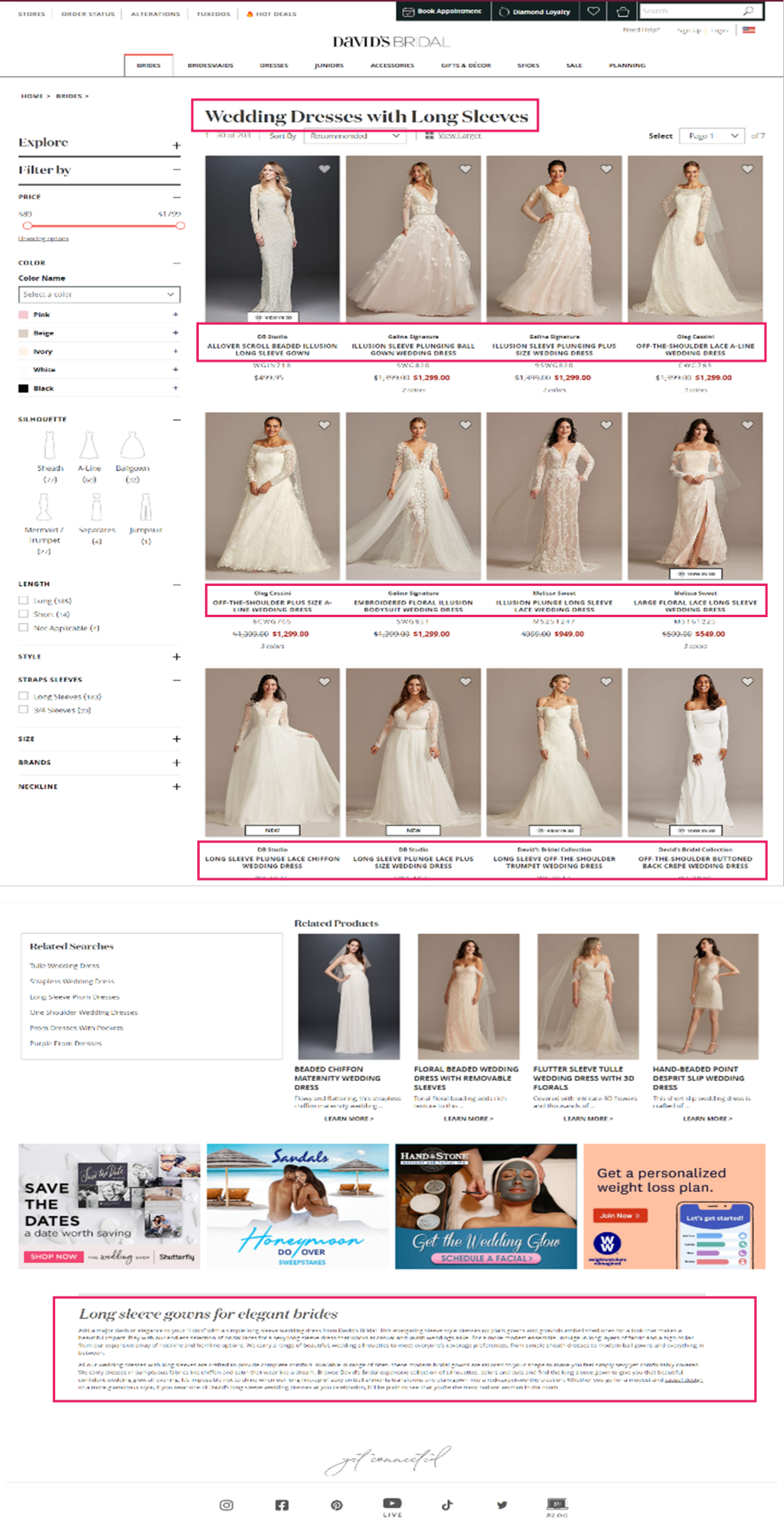
6. Provide accessibility and build page authority
Once you’ve opened up your new facet Product Listing Pages, you need to begin cultivating link equity towards them. This will ensure that they don’t exist as orphan URLs with no PageRank:
Ensure they’re referenced in your product XML sitemap.
If you have one feature per facet URL, then add them to your faceted navigation across CLP and Product Listing Page pages.
If you have two or more features per facet URL, then create a “Popular Searches” or “Related Searches” option within your CLPs.
Utilize your mega menu to showcase your new category landing pages. This will not only allow you to direct a large proportion of link equity, but it will also secure the highest click-through rate amongst your visitors.
Integrate your editorial strategy by creating engaging content with in-copy links. Think about how you can use descriptive long-tail anchor text about the Product Listing Page you want to link to rather than relying on “click here” or “see more”.
Connect to them via href links so you’re not solely relying on links from the main navigation or content hyperlinks. As this is difficult to do at scale, it can be done through modules such as “related categories”, “other subcategories”, “related products”, etc.
Devise strategic outreach campaigns that will secure quality, external backlinks to them.
Implementing this holistic and robust strategy will help you to secure exponential growth from your new commercial landing pages.
Conclusion
There is a great deal of organic opportunity that exists within your faceted navigation if you begin to leverage mid- and long-tail search terms.
Seek out the opportunity from extended keyword research and competitor analysis before deciding which variants fulfill consumer demands and deliver optimal organic sessions and onsite conversions. Configure a single faceted URL for each opportunity and open them up for crawl and indexation. Ensure PageRank is distributed to them (both internally and externally) and develop your landing page content in line with quality optimization practices. This approach will help you to avoid having crawl inefficiencies, over indexation, cannibalization, or having thin doorway pages. In turn, your website will be better suited to attract highly-targeted users and guide them down the purchase funnel.
Maximizing UX and reducing reliance on other marketing channels means that your faceted navigation can truly deliver organic ROI. We have seen this work for our clients.
0 notes